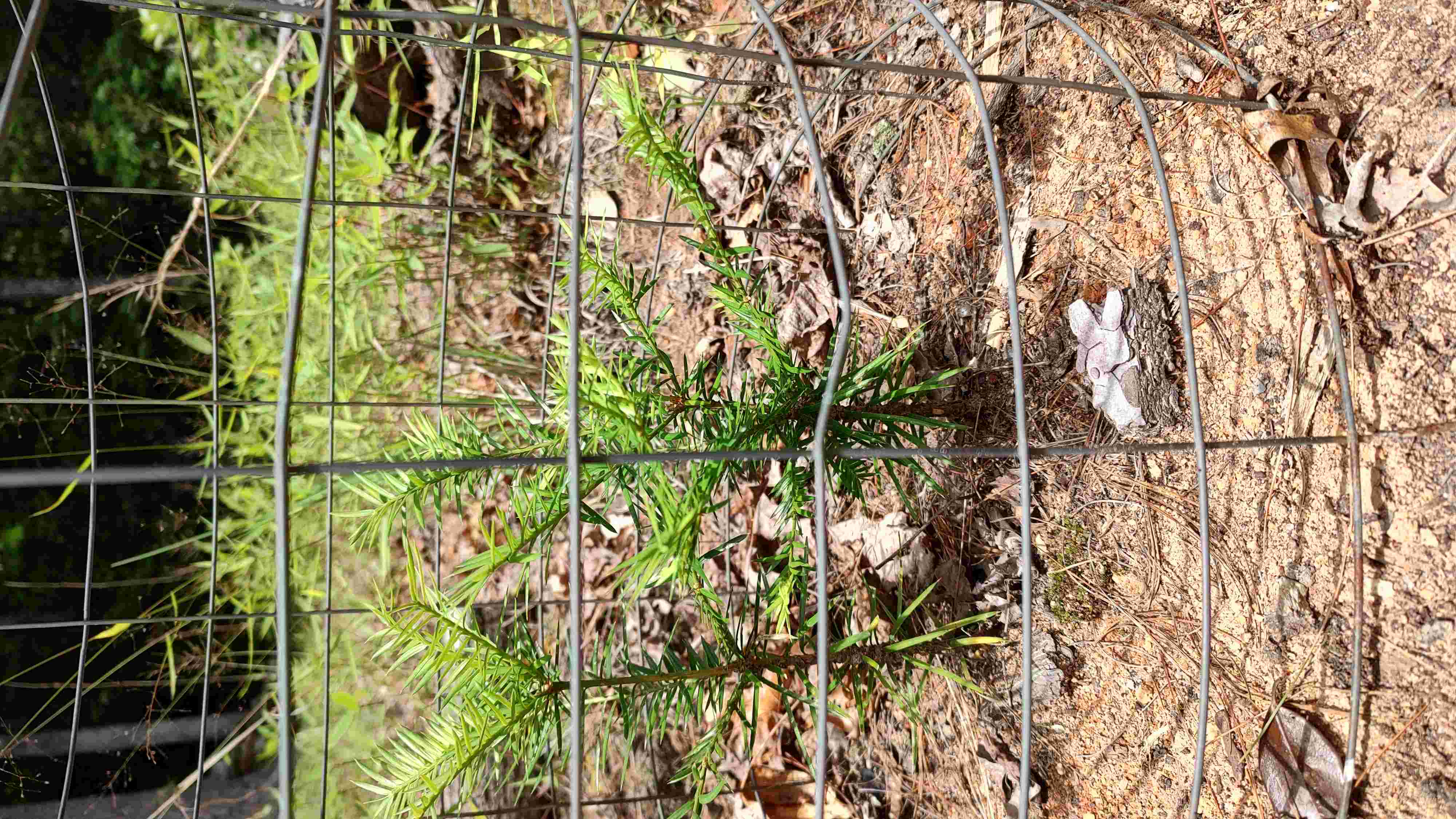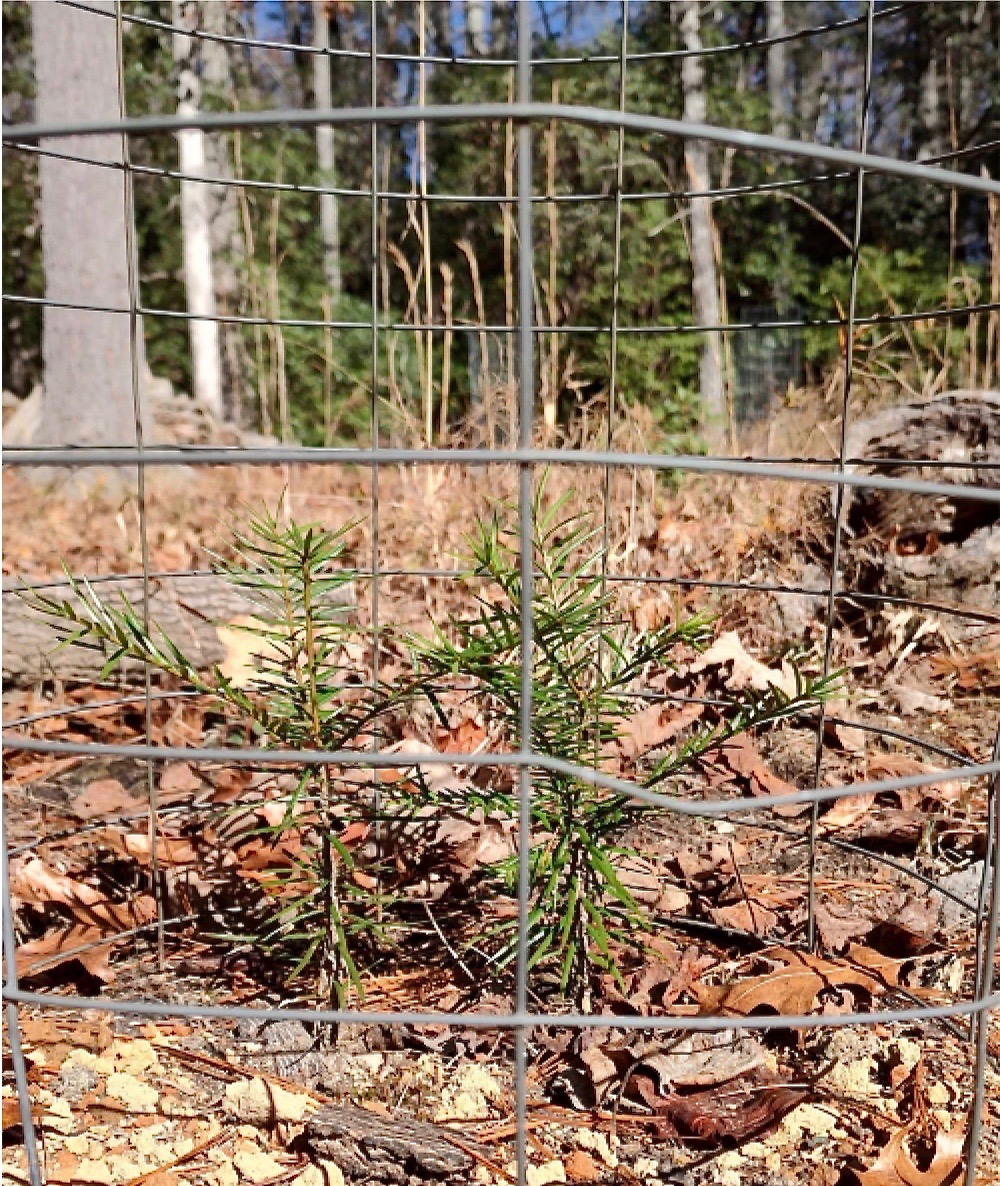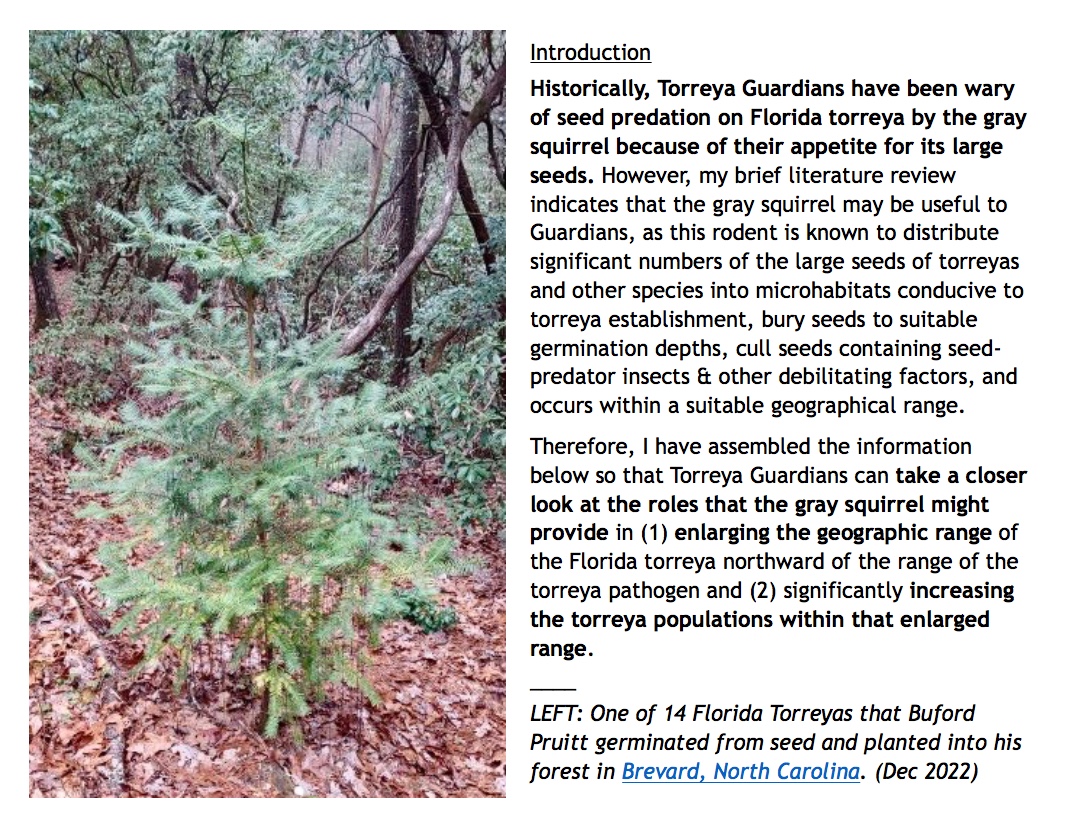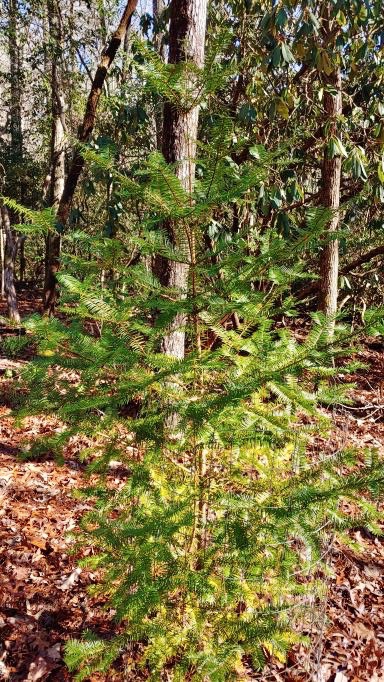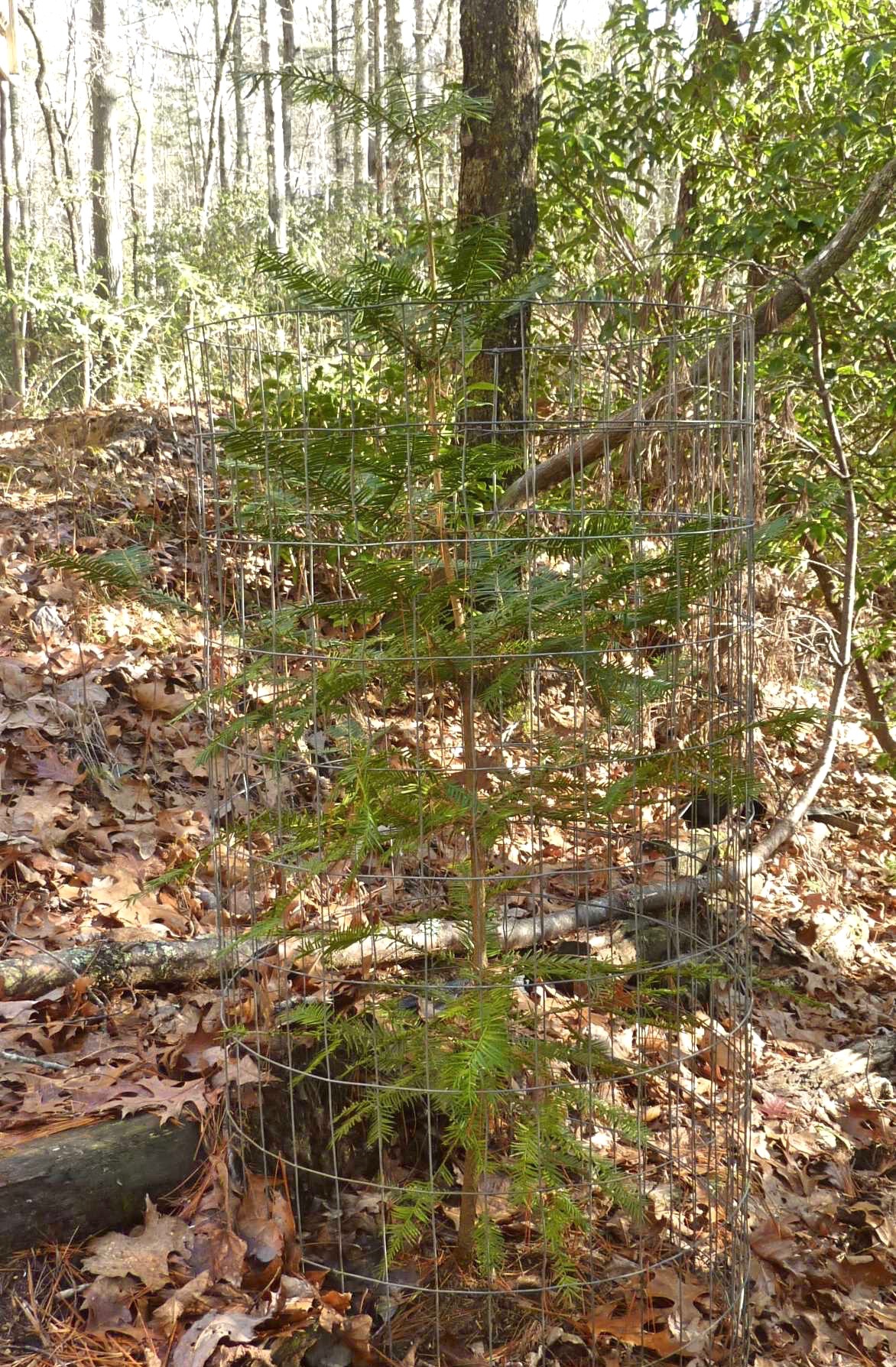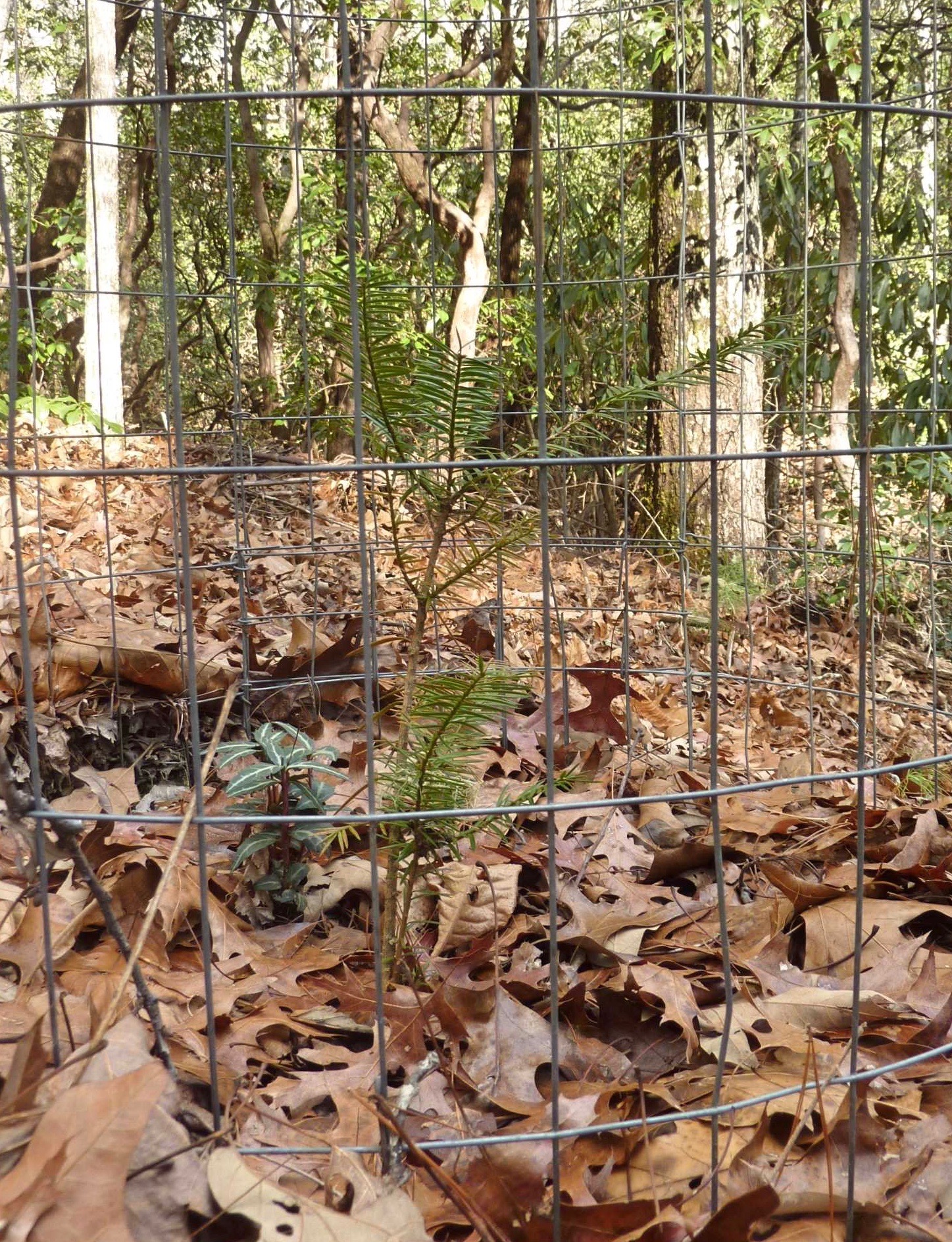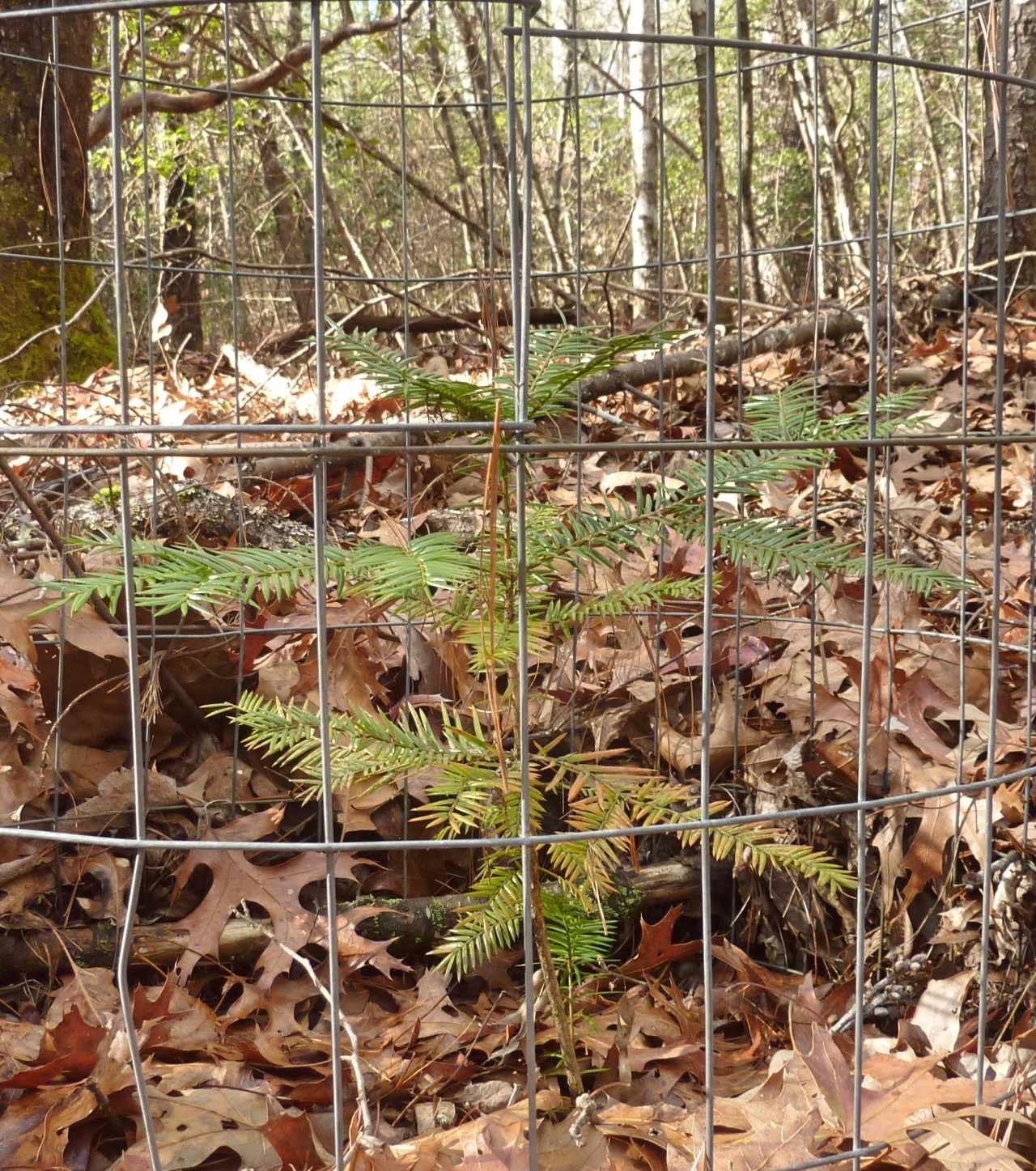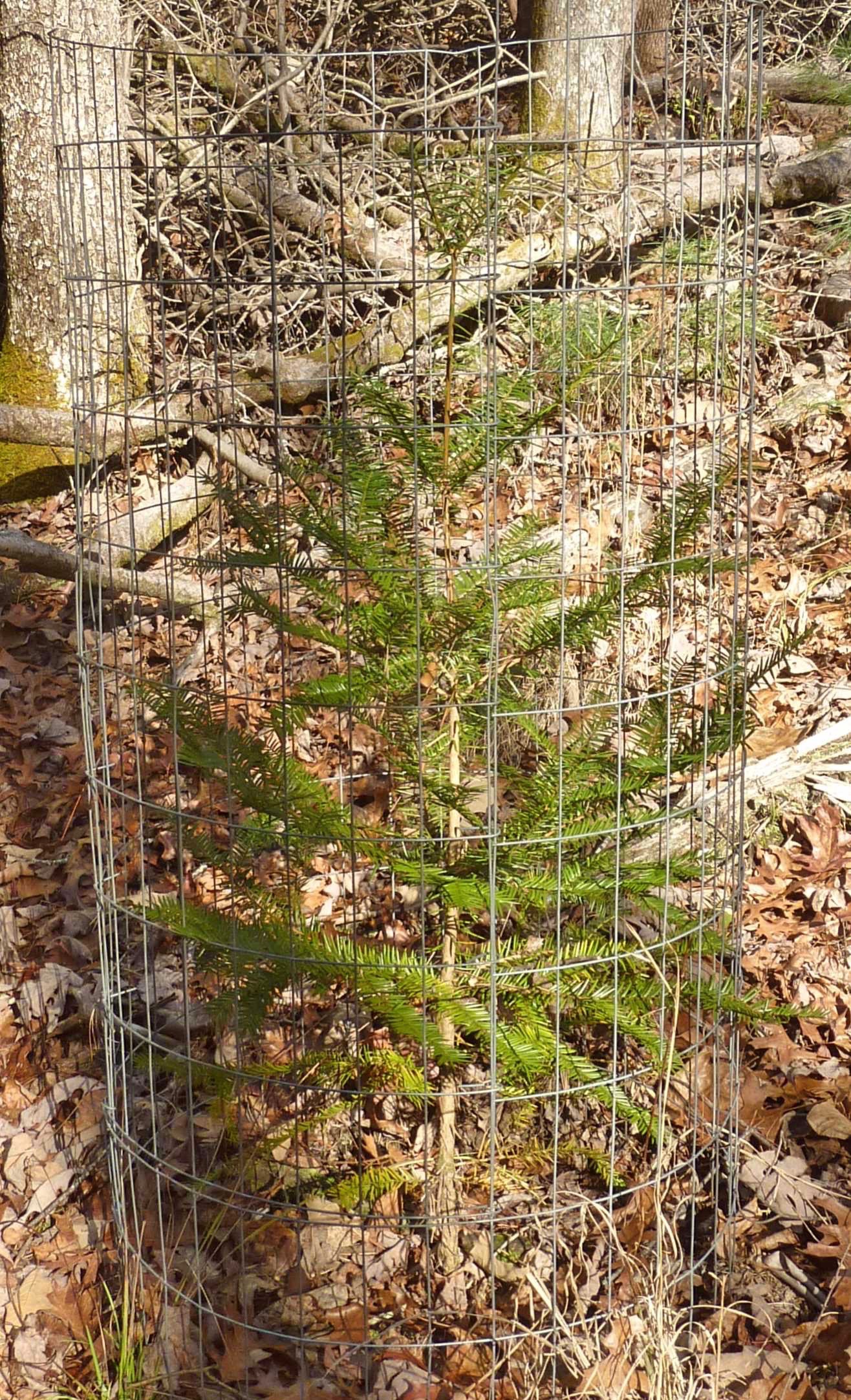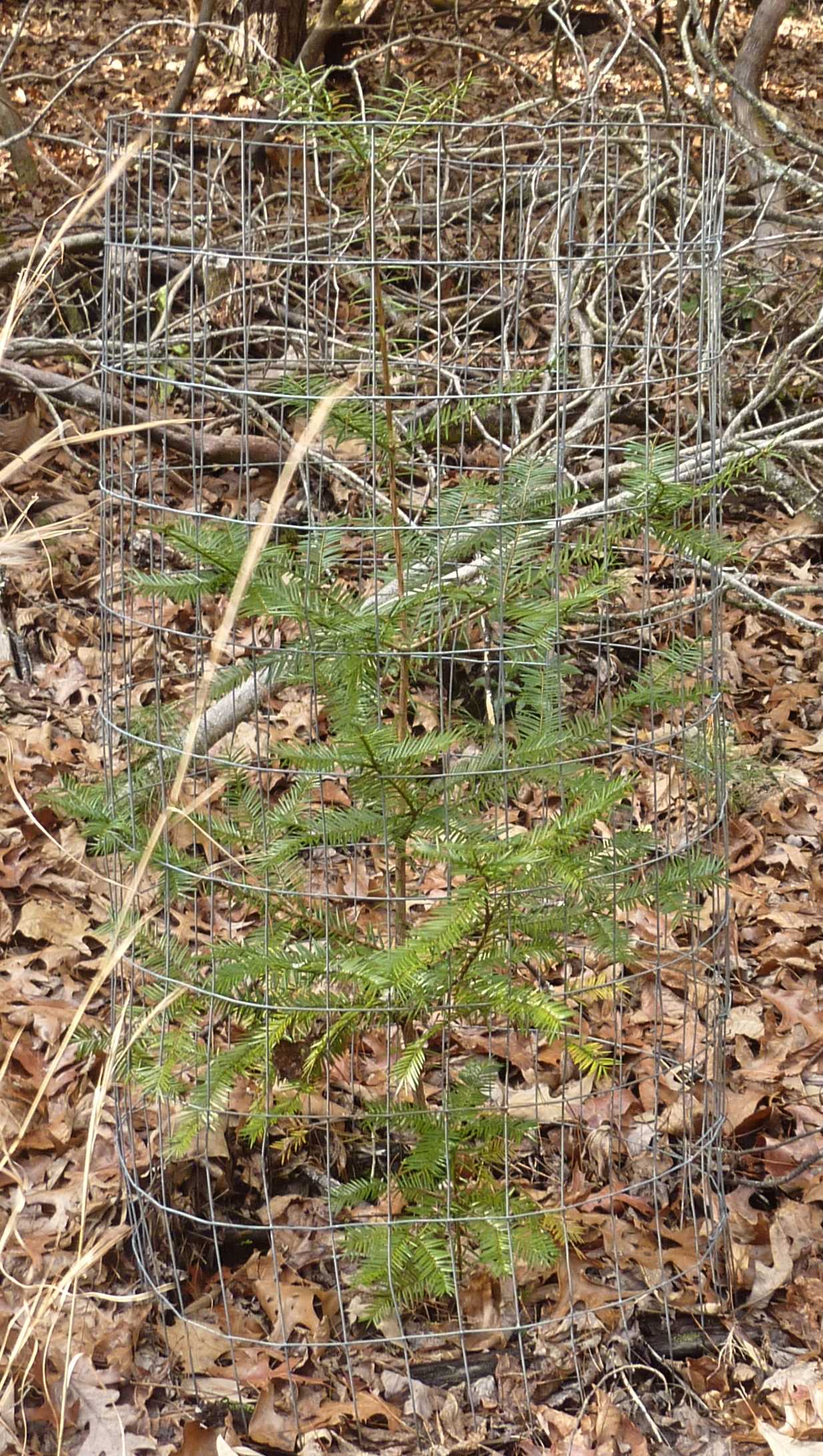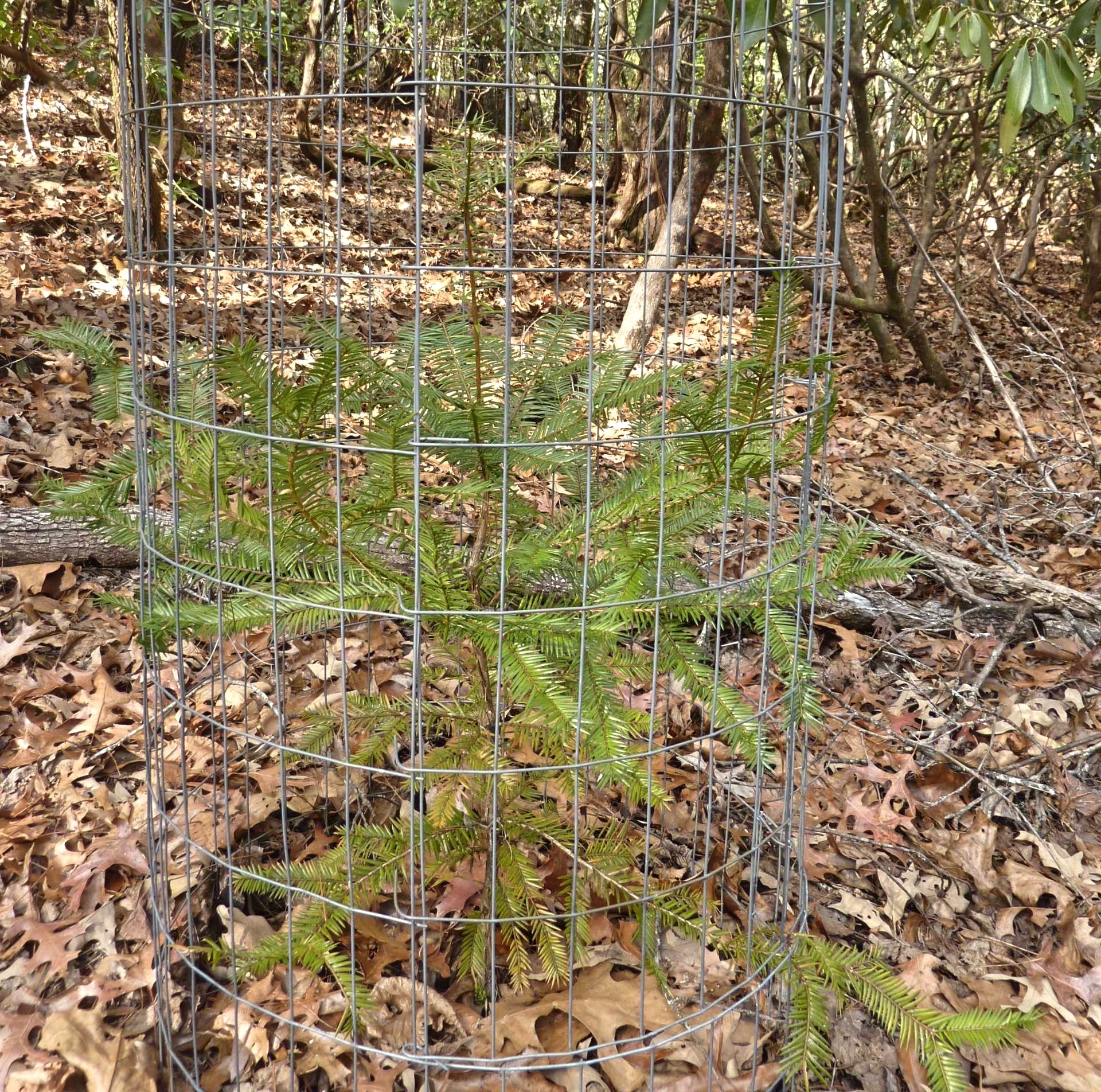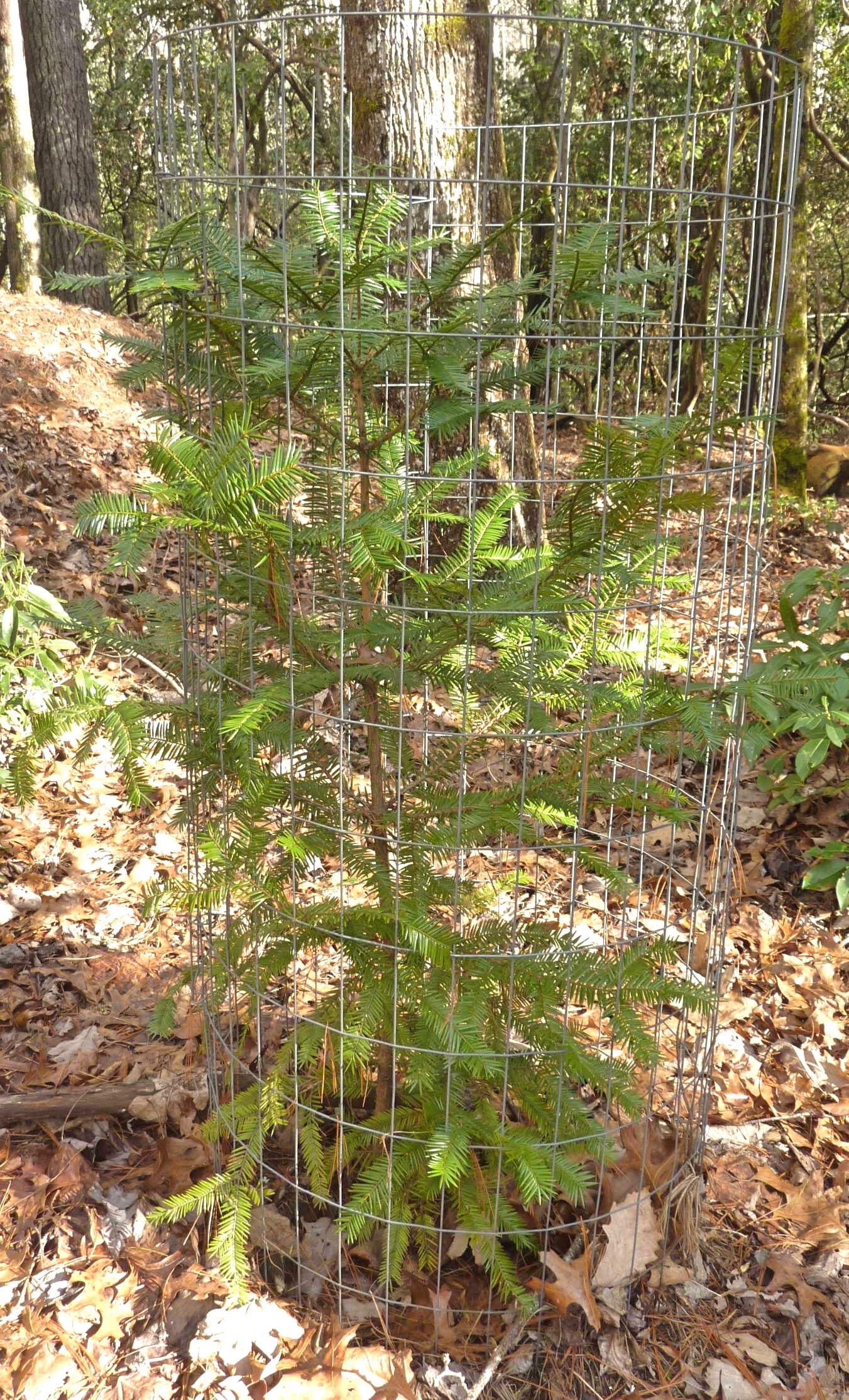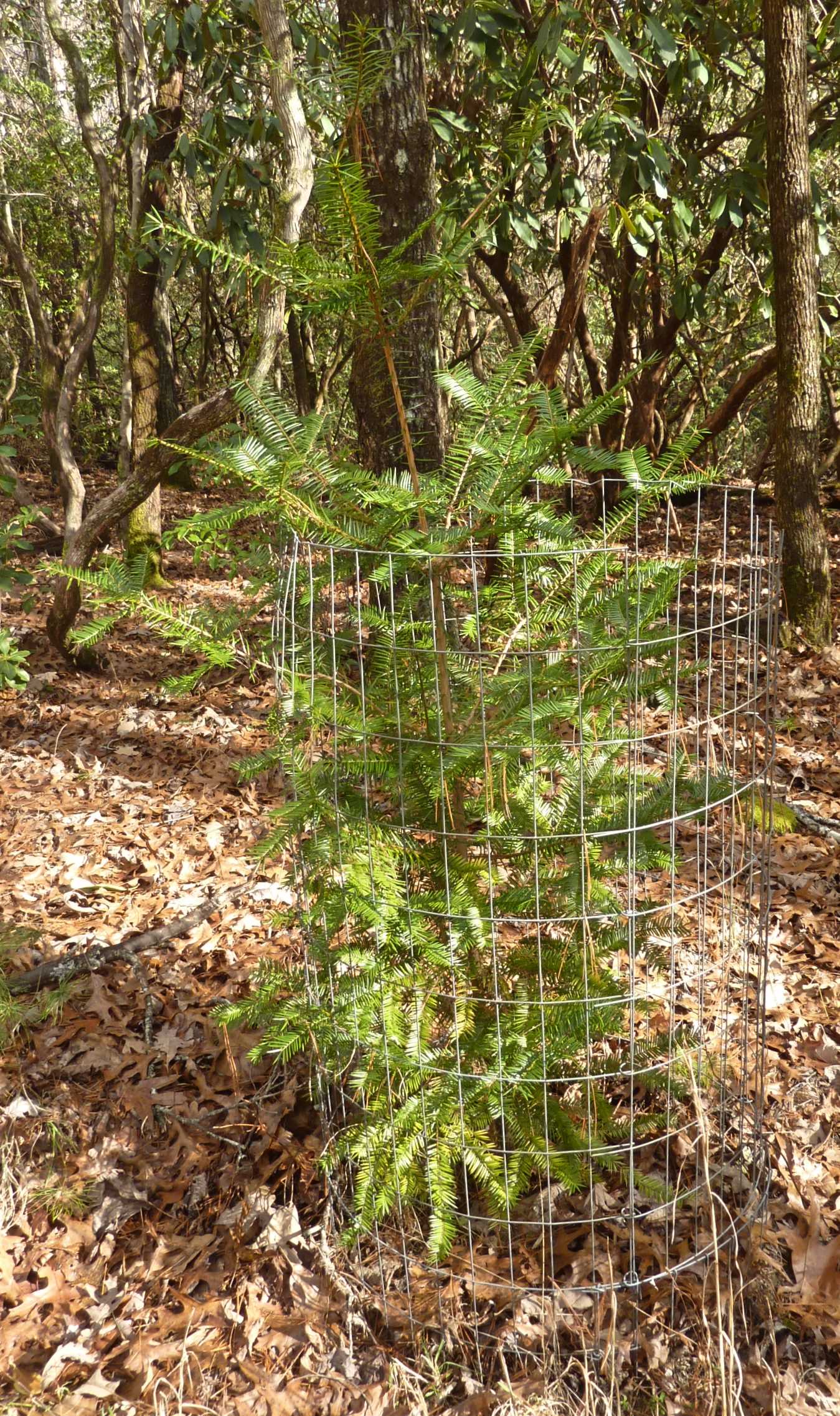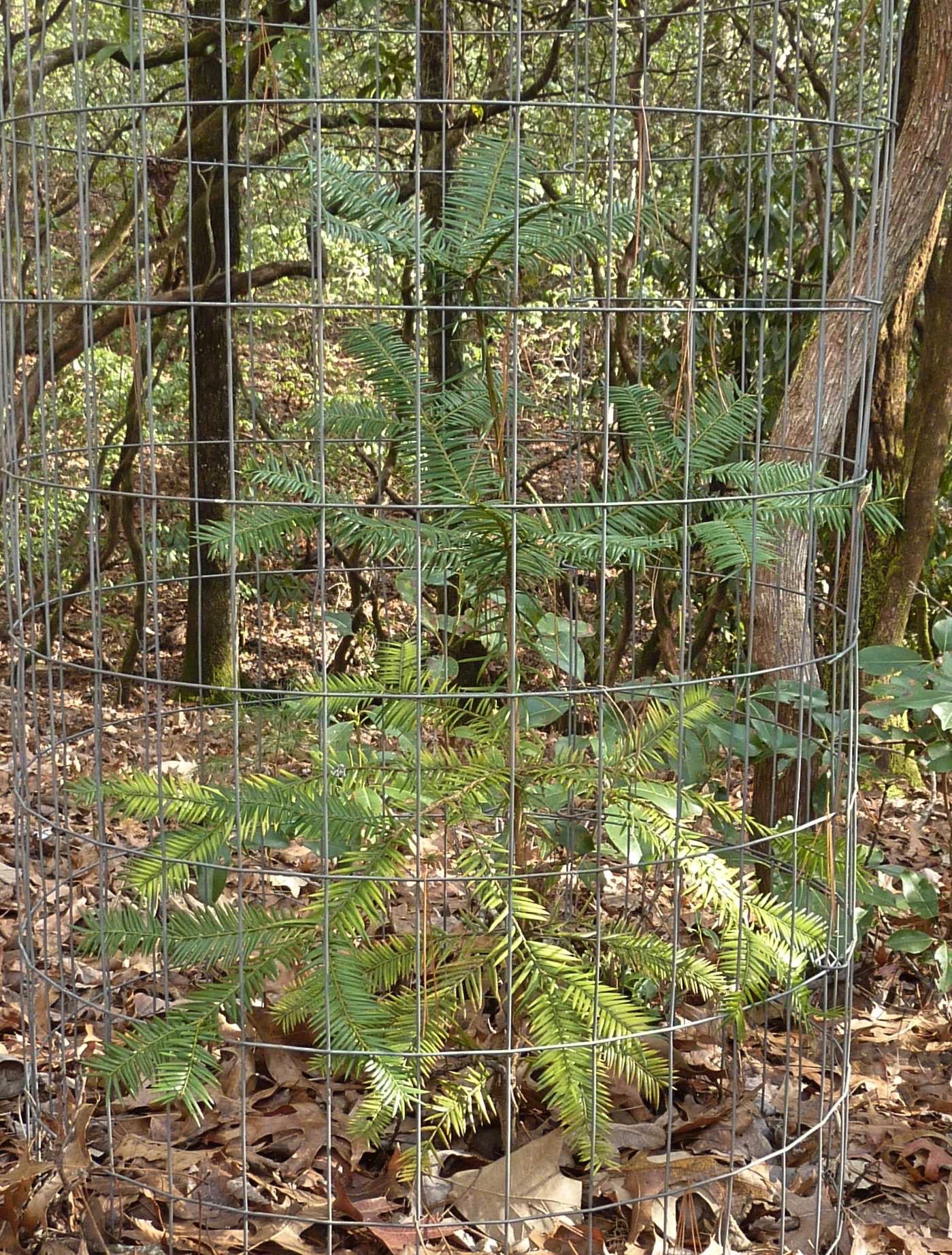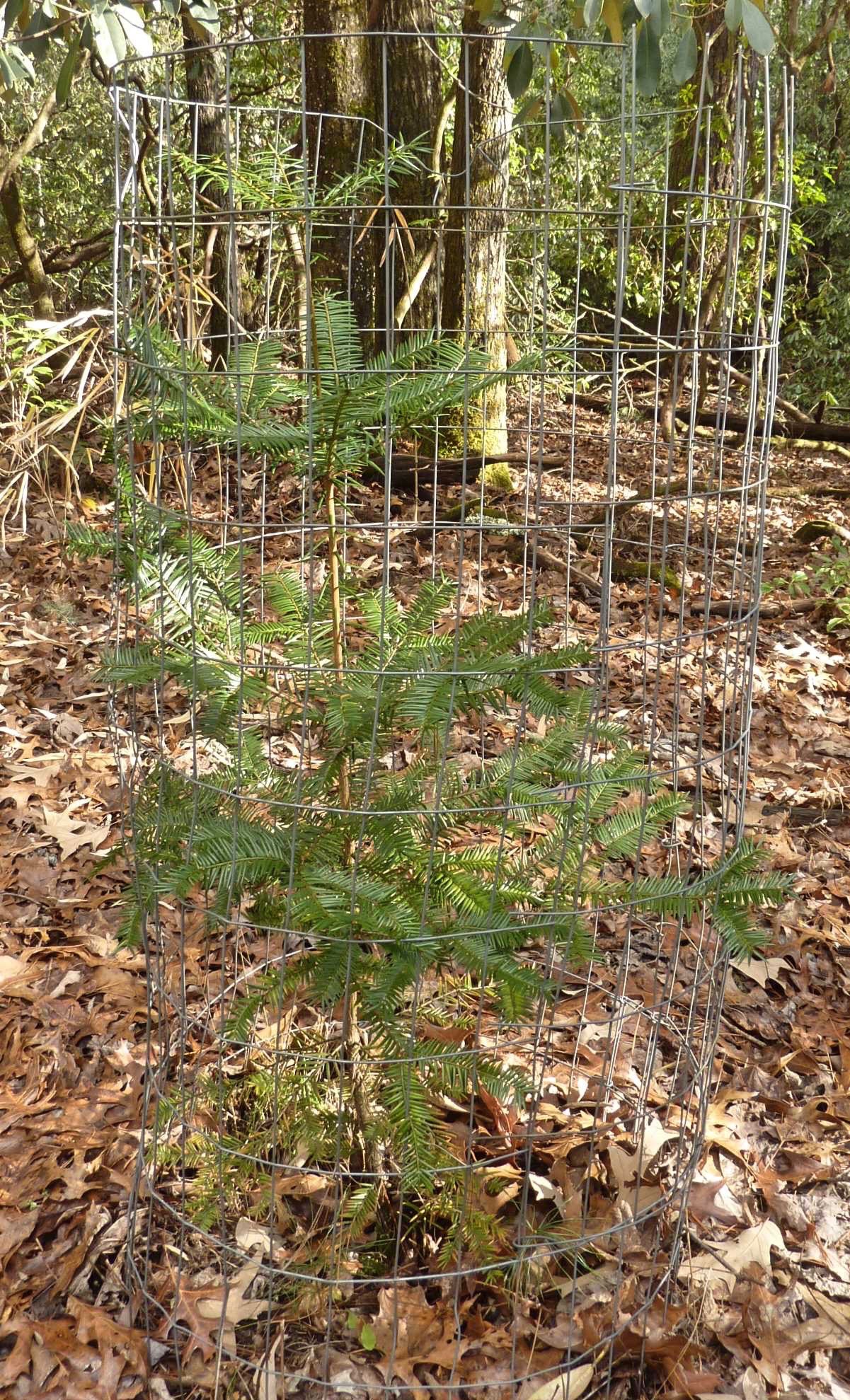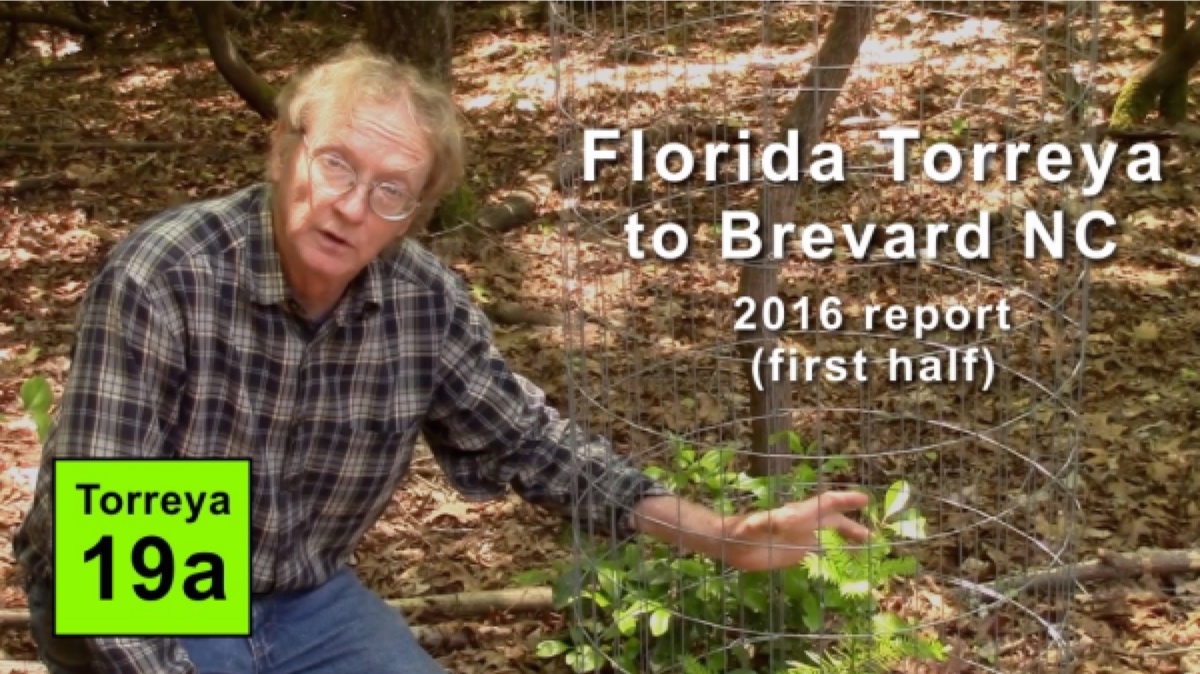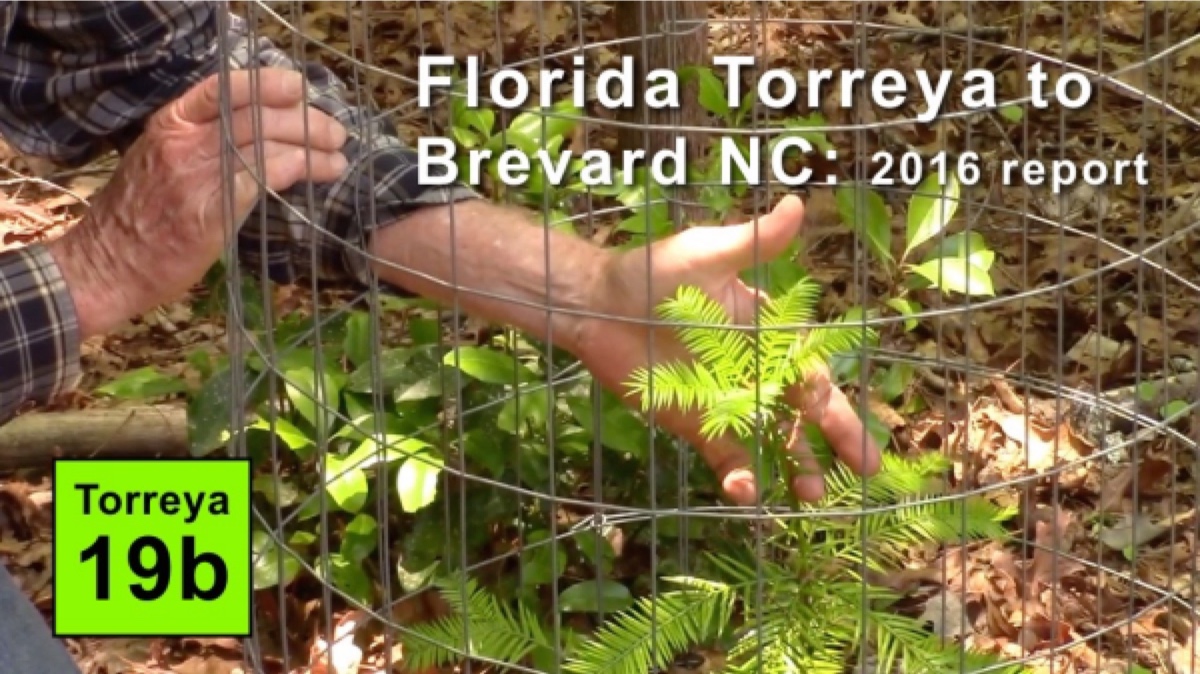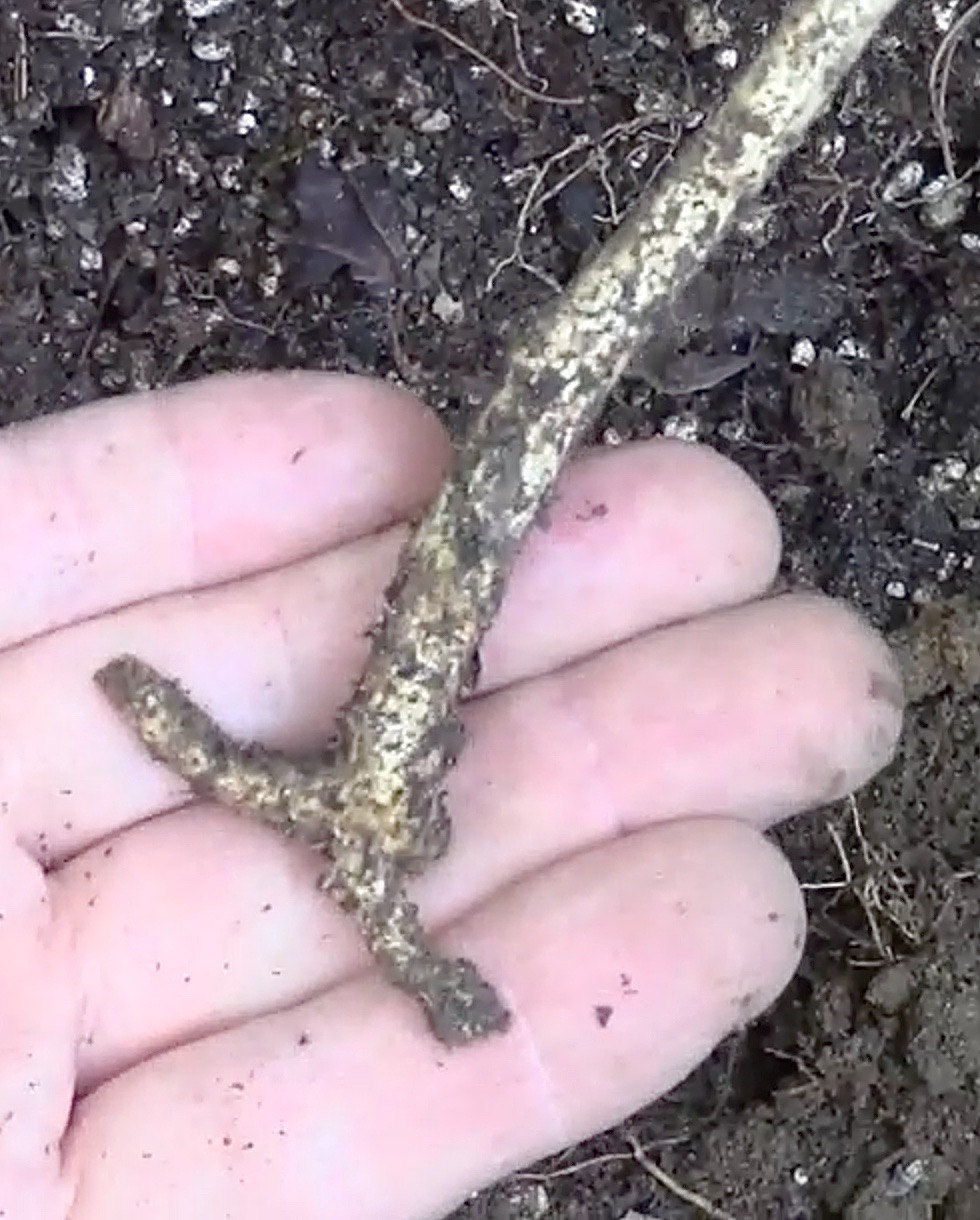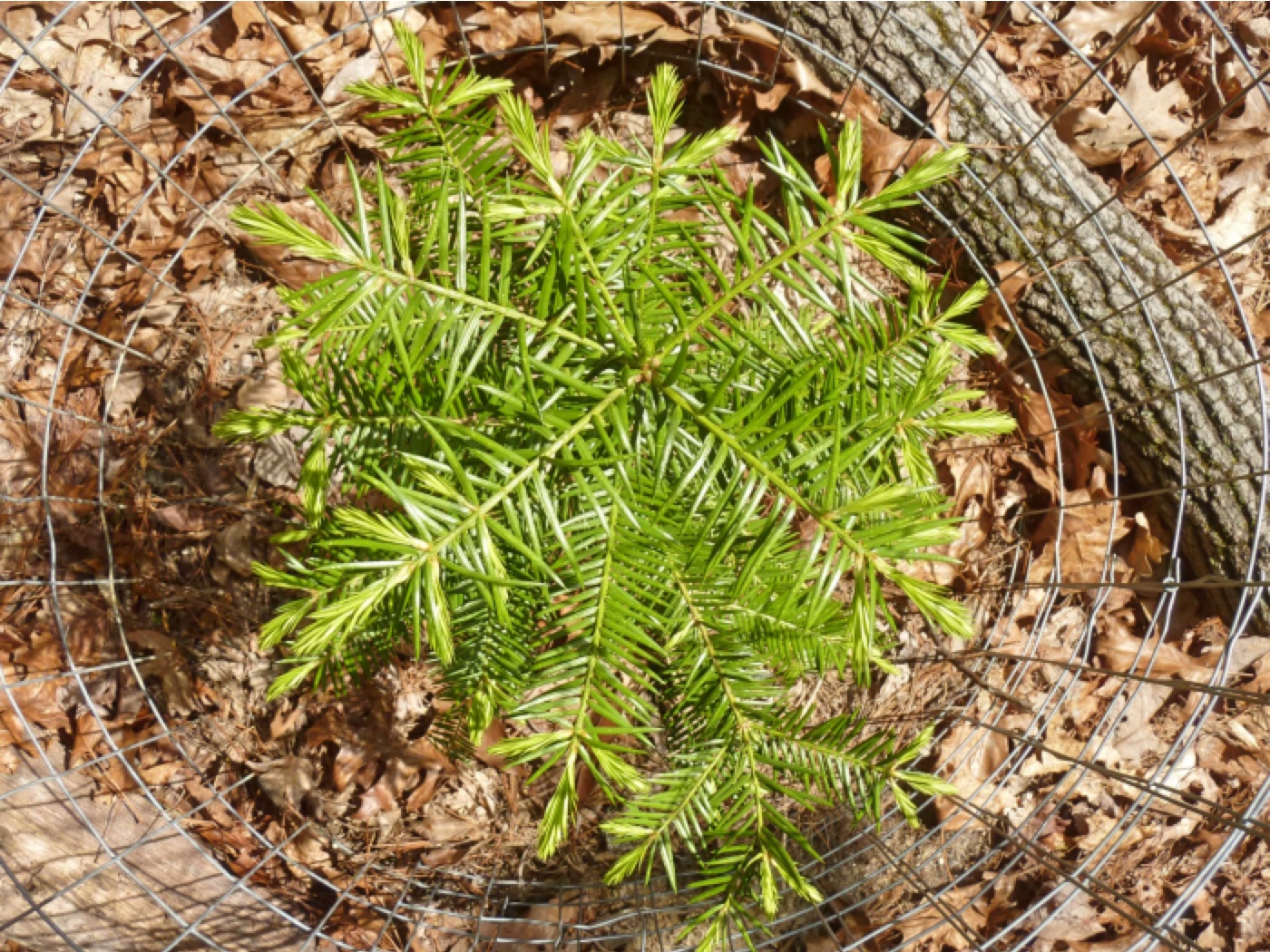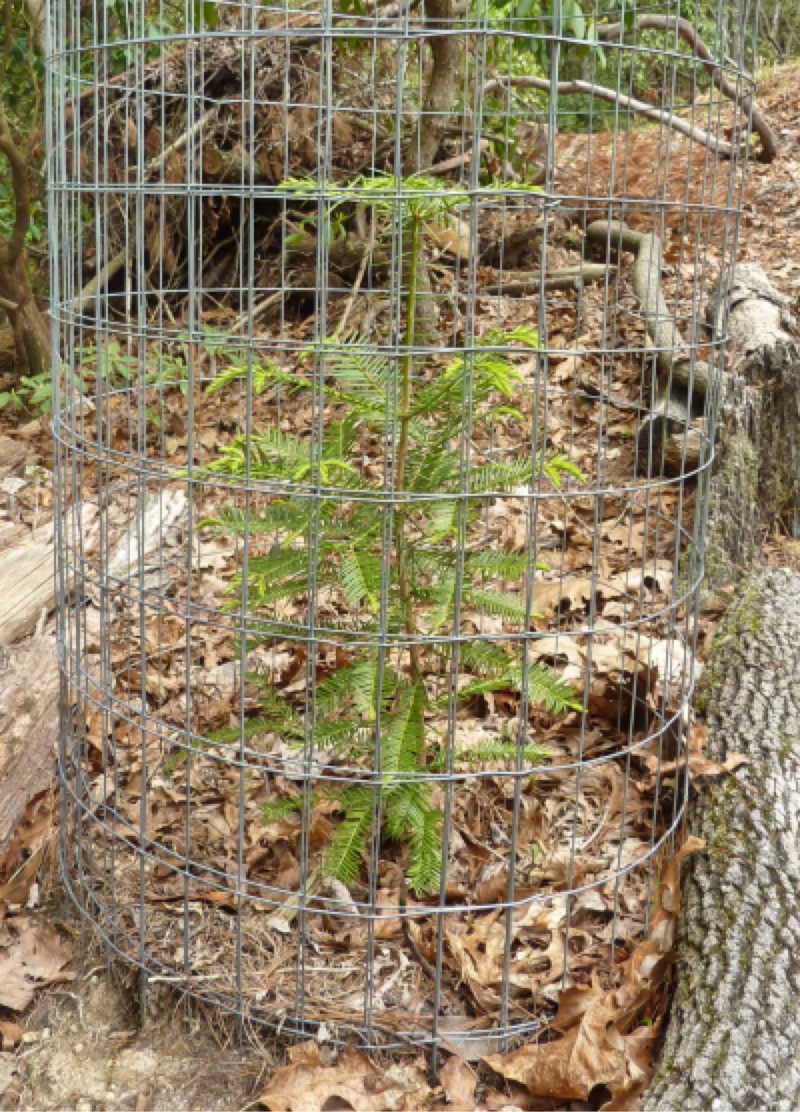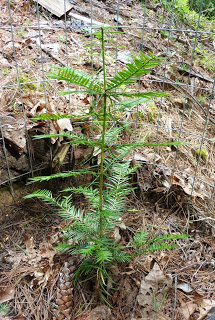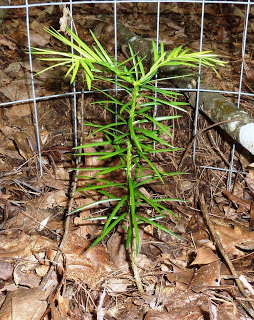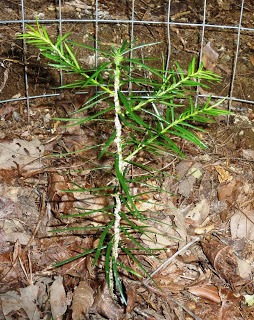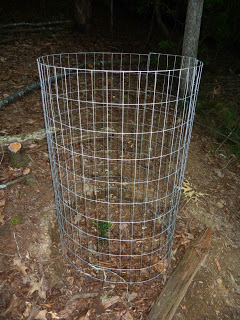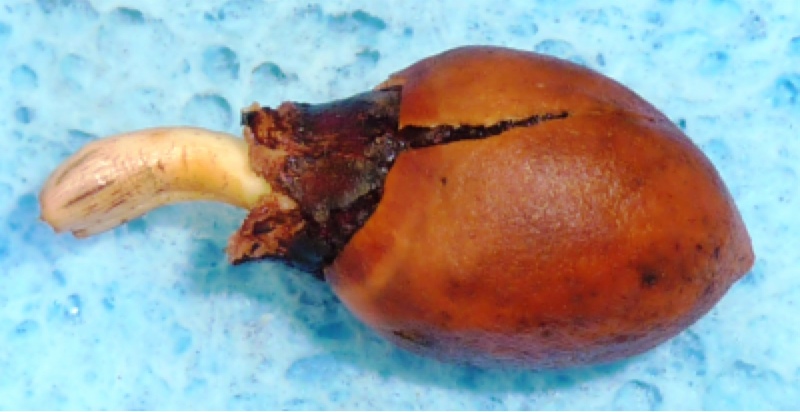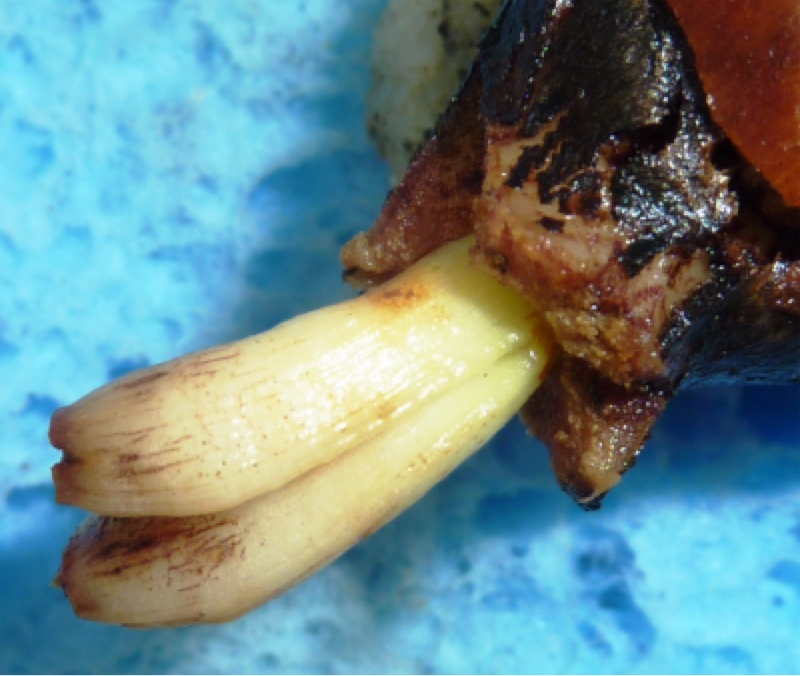
Torreya Guardian volunteer: Buford Pruitt, near Brevard NC
SITE DESCRIPTION BY PRUITT: Within the Gneiss Belt mountains at an elevation of approx 2,450 ft MSL. The property is mature mixed pine and hardwoods, which cover all but the half-acre house pad and driveway. The parcel is within a low density residential area, with lots being 2 - 10 acres in size. My own lot is 2.24 acres. No one in the neighborhood has cleared their land, all preferring to live within woods.
Brevard, NC: Buford Pruitt received in 2010 and 2011 newly collected T. taxifolia seeds by Torreya Guardians. He writes, "All of my Torreya seedlings were germinated in potting soil and planted at my Transylvania County, North Carolina, lot (USDA planting zone 6) in the Blue Ridge Mountains. The seeds were provided by Connie Barlow." Barlow resupplied him with seeds from the 2021 horticultural harvests in North Carolina: 10 standard size seeds plus 6 very small (half from Mt. Olive and half from Clinton, NC).
Reverse Chronological Reports * * * * *
• June 20, 2025 - Status Report
BUFORD PRUITT writes: After incubating in sawdust in a wooden seed box outside for two winters, 14 torrey seeds have finally sprouted over the last few weeks. Some are still pretty new, so more may sprout soon. These are the ones given to me by Fred Bess [Cleveland OHIO seed producer] two autumns ago: 2023 harvest. PHOTO LEFT: You may recall that after a single winter, two sprouted last spring from among the seeds that Fred suggested I insert within natural habitat leaf litter. [Scroll down 9 rows of photos to see what the pair looked like May and November 2024.] They germinated in a place that I would not have placed them, as it was too close to a picnic table. Furthermore, they sprouted only a few inches apart, yet I would not have purposely set them that close together. Thus, I bet they were found, moved, planted, and forgotten by a squirrel. I transplanted them to a sunnier area last spring. They then just sat there all last summer, but this spring and summer they have begun growing nicely. After seeing the new sprouts, I inspected the locale where I distributed the other seeds Fred gave me. Nothing. Maybe the squirrel ate them, or maybe some of them will sprout yet. We'll see. As you may remember, I have another 14 (total 16) in the ground from 2010 etc harvests. Several of them are well over 6 ft tall and two are over 8 ft high. The third eight-footer that was damaged by a falling snag last year is recovering nicely. [The 14 older trees are all shown in the November 2024 entry below.]
• November 2024 - Status Report on all 16 torreyasI now have 16 living Florida torreys. I germinated one from 2009 seed, 13 from 2010 seeds, and 2 from 2023 seeds. I measured the heights of them at end-autumn 2022 (photos farther down this page) and also November 2024 (photos directly below).
NOTE ON DAMAGED TREE N: May 2024, a 6" x 50' snag fell across Tree N, which was one of my largest torreys. The snag reduced the 2" x 4" x 48" fencing wire deer exclusion cage into a crumpled mass, which I removed entirely. Several branches were killed (20 to 30% of the foliage), the apical meristem was broken off, the trunk suffered bark avulsions that leaked sap, and the was tree leaning over. I removed the dead branches and tied the tree to a rhodo to put it back upright. The tie later broke, but the tree now stands almost straight up anyway, so I did not retie it. 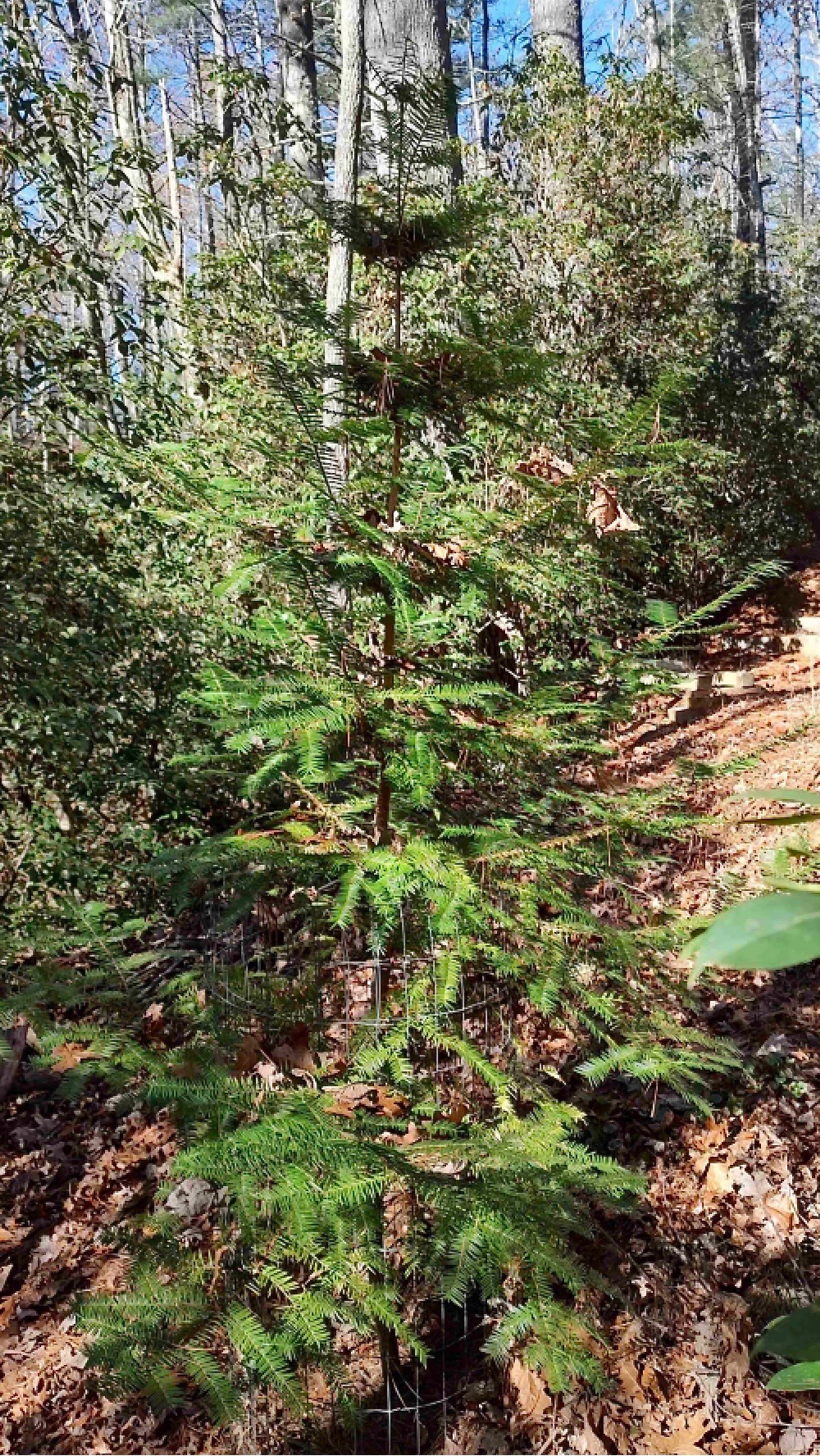
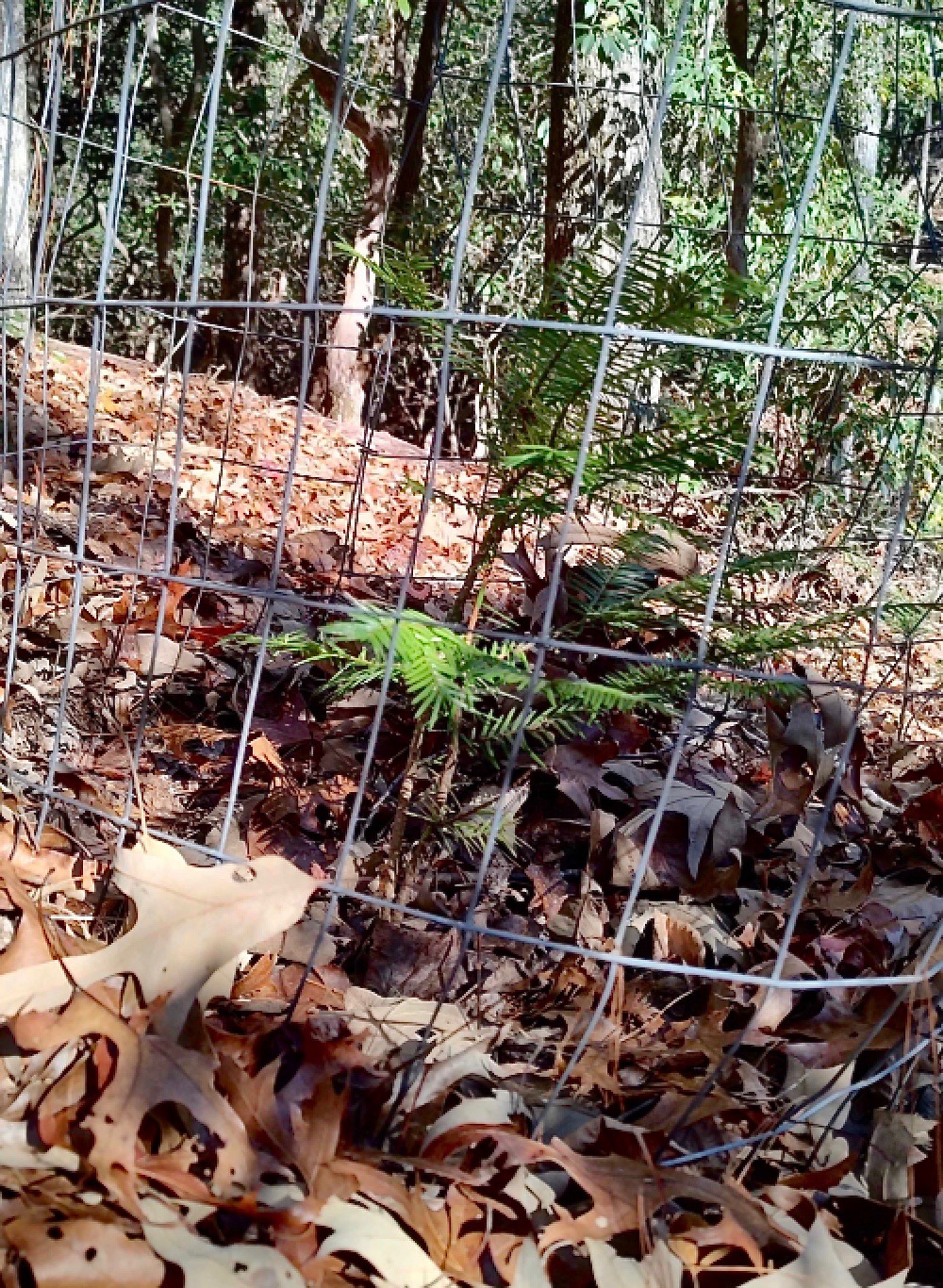
Trees A and B
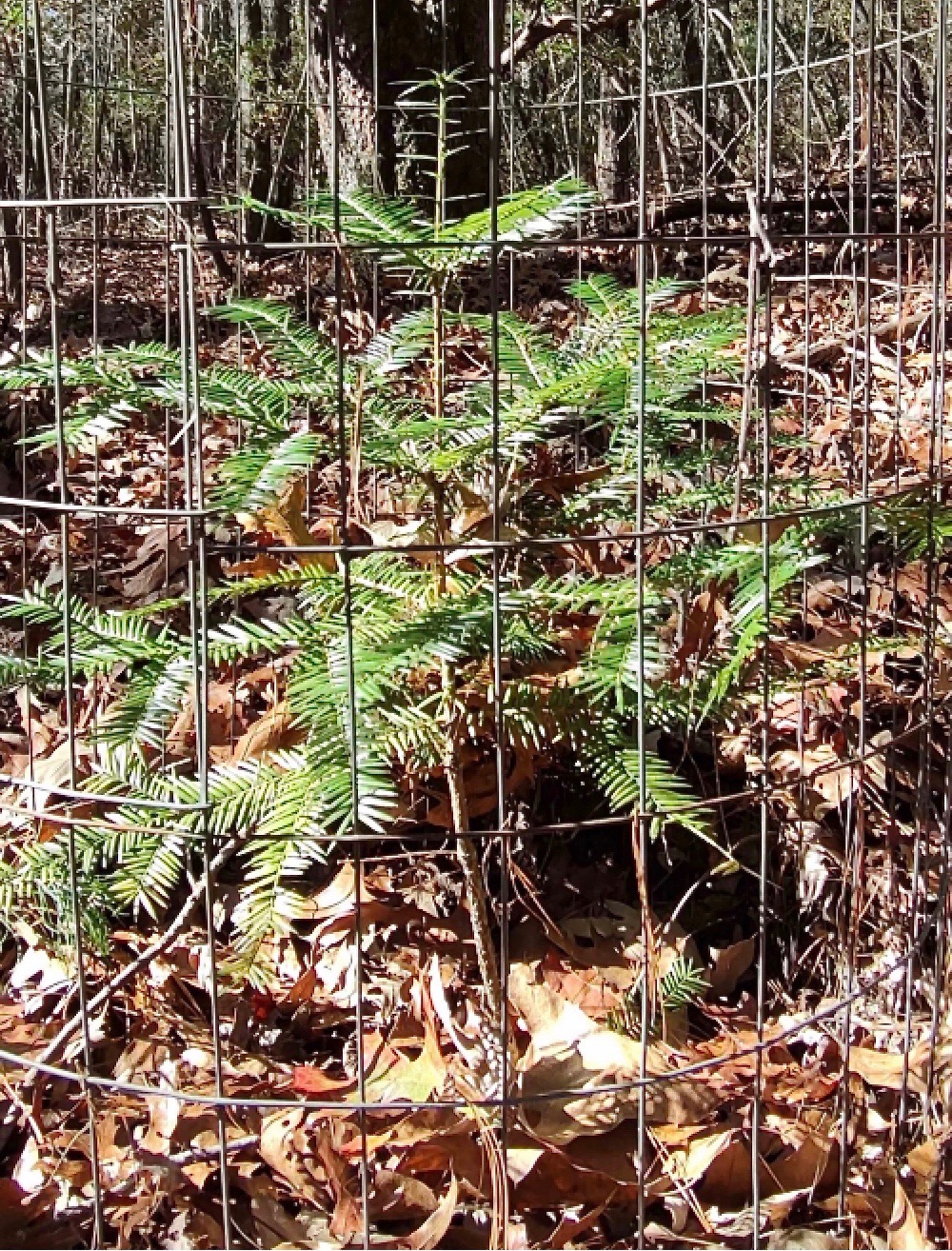
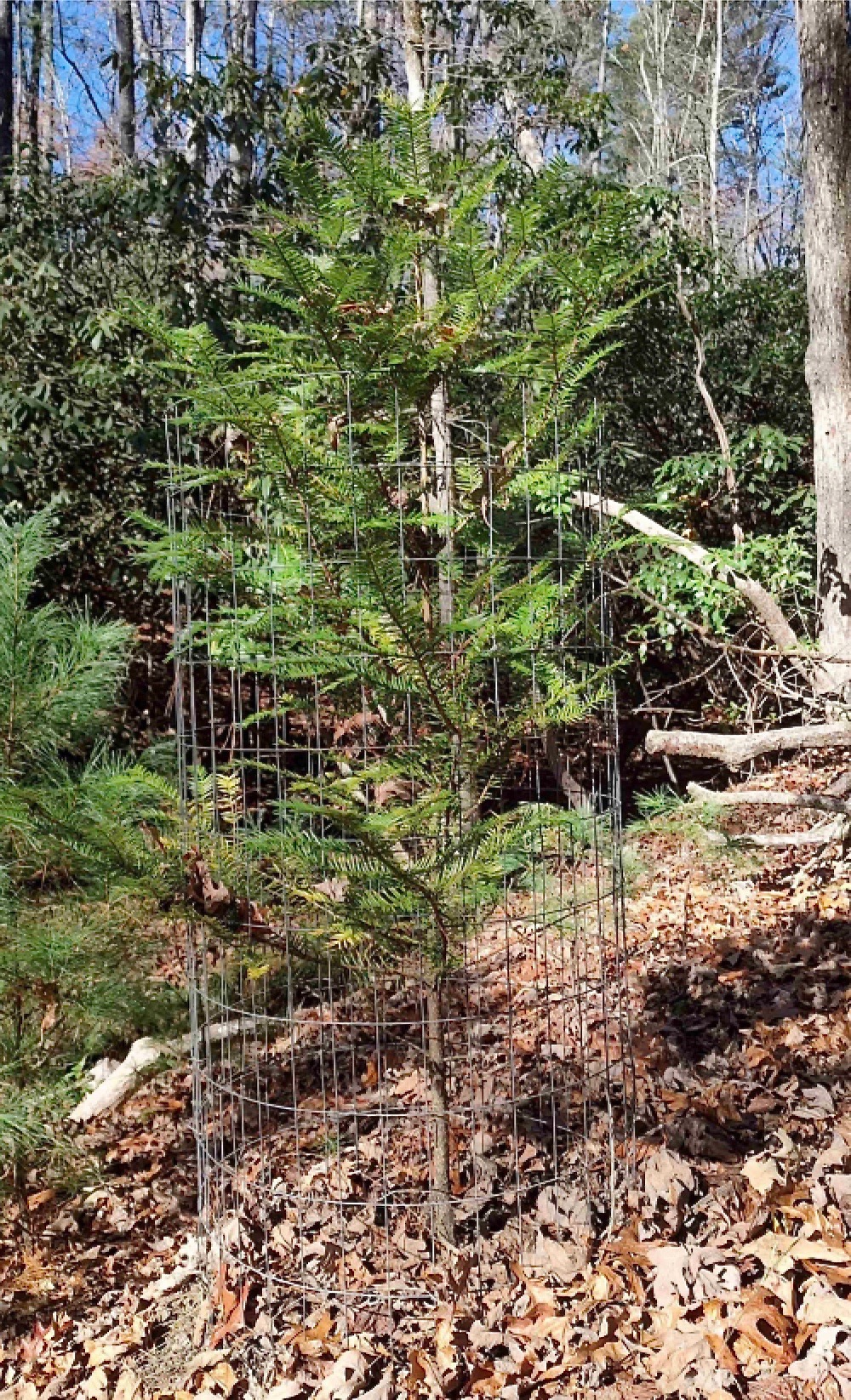
Trees C and D
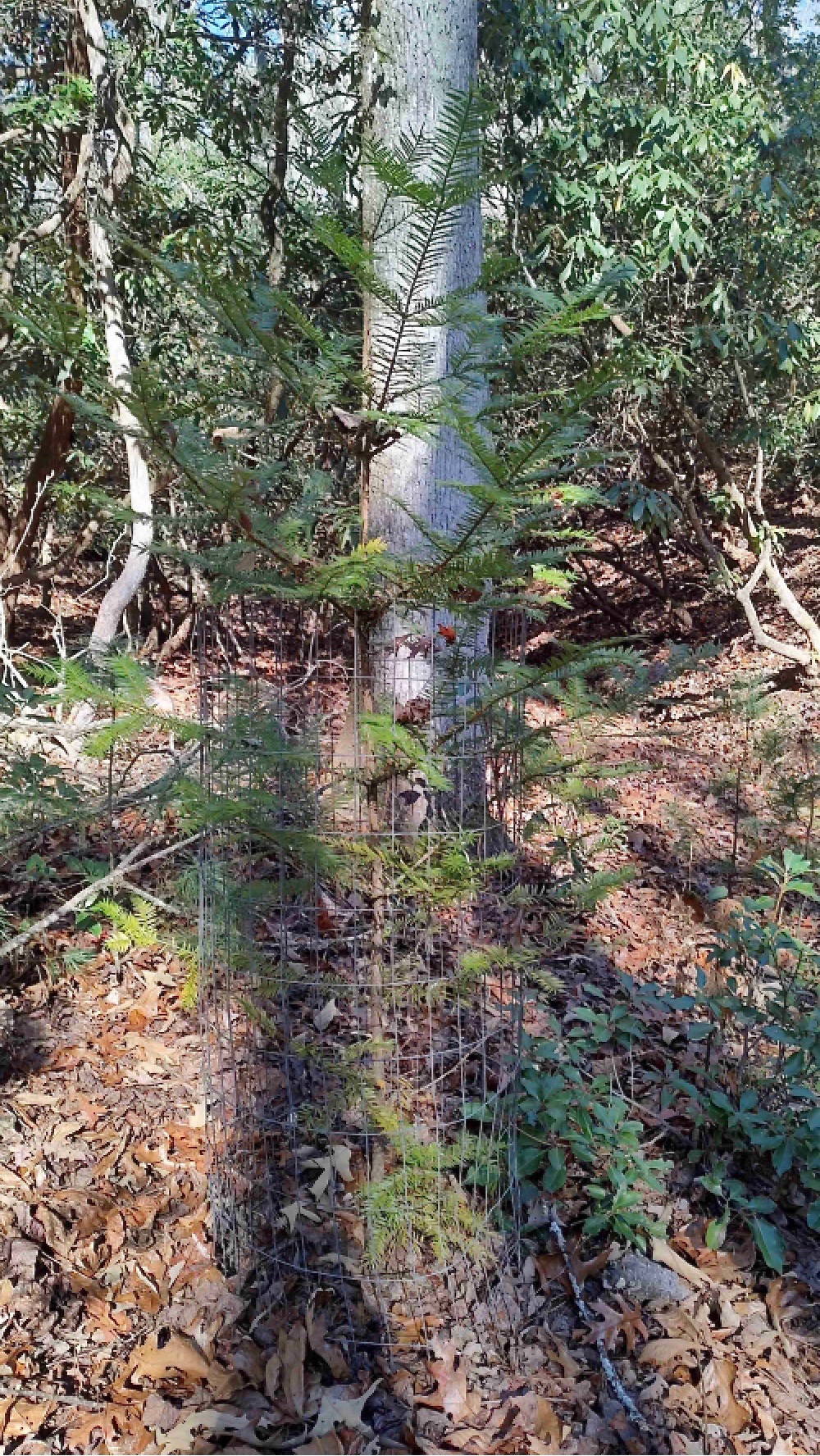
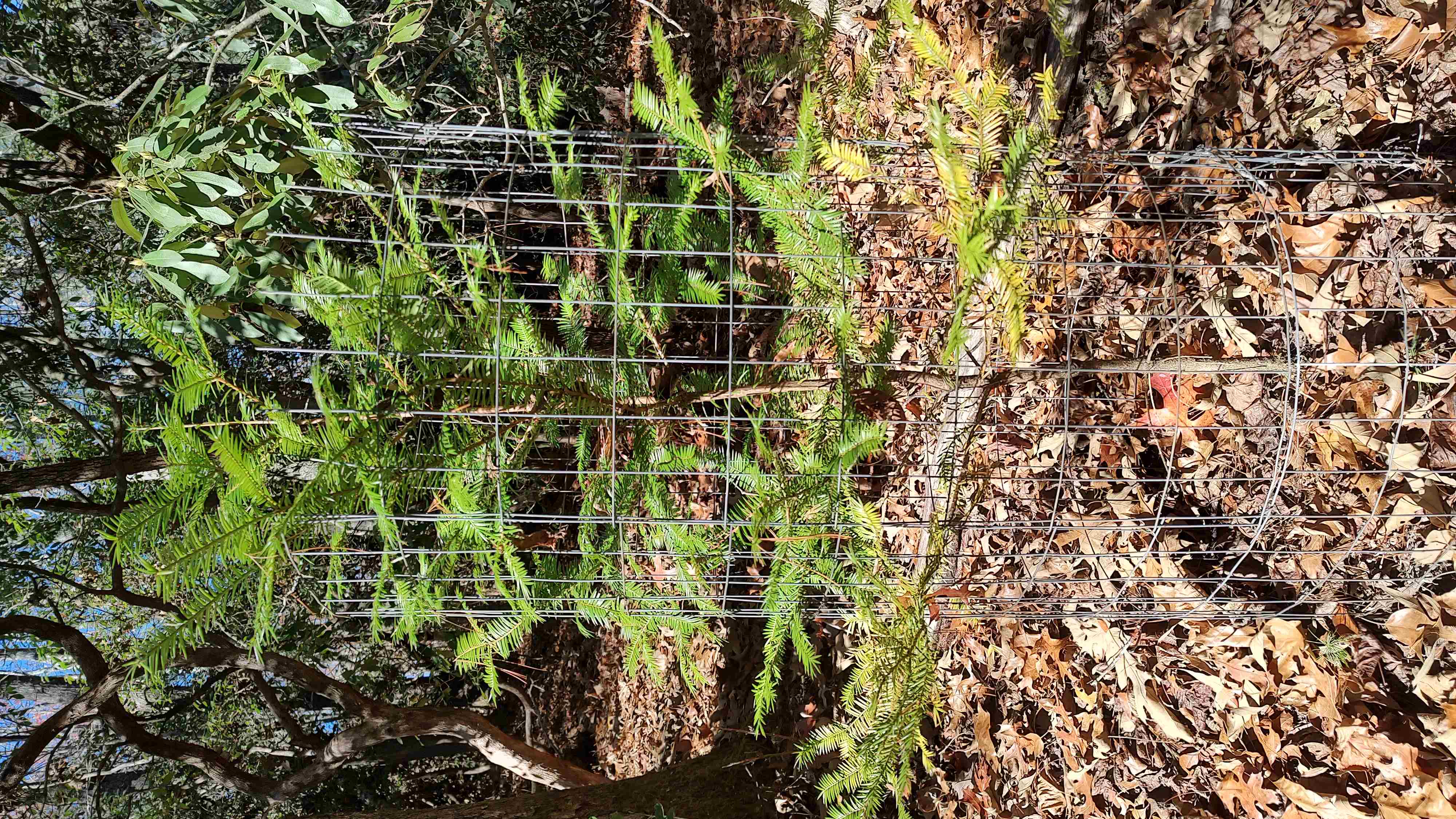
Trees E and F
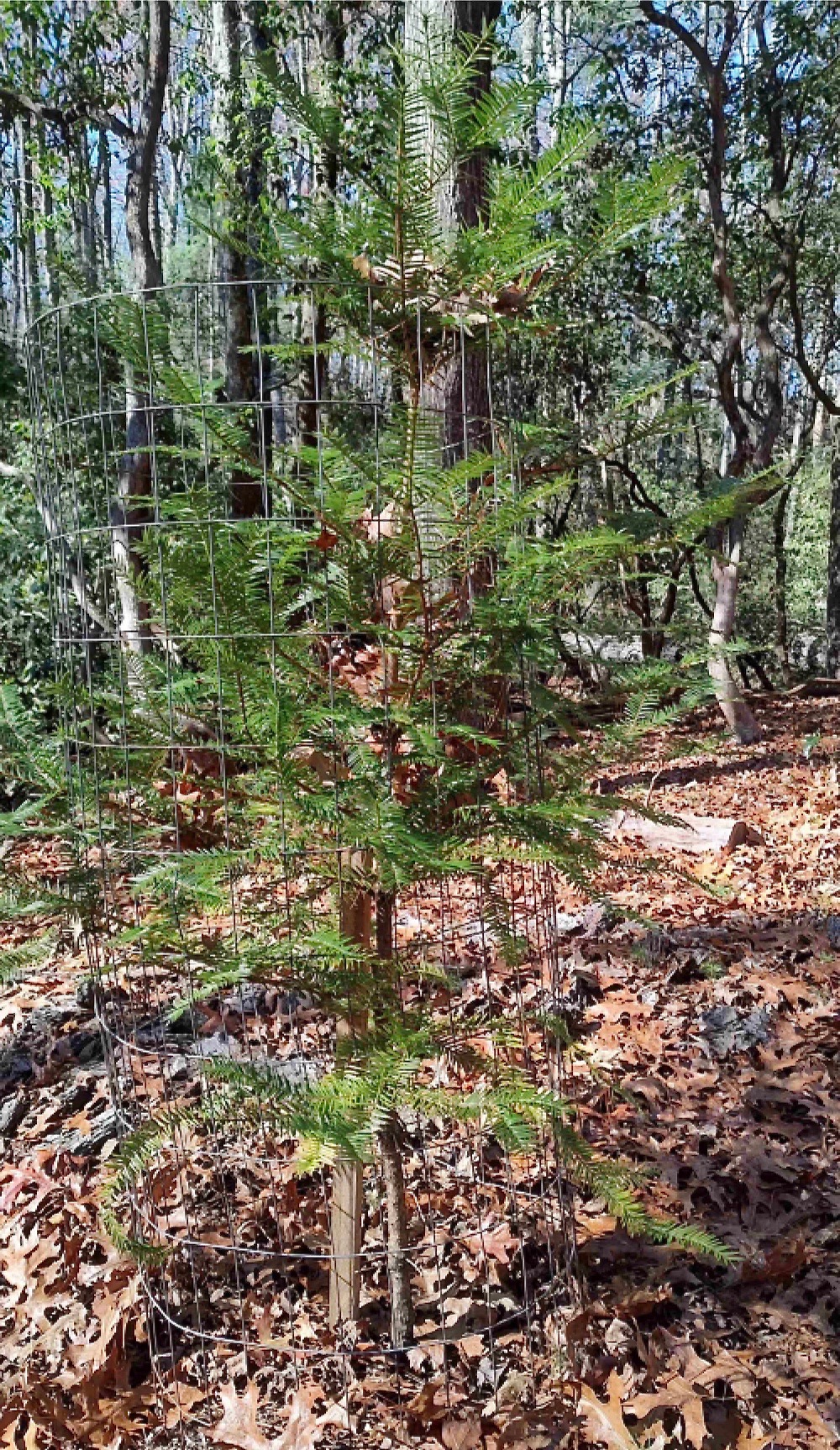
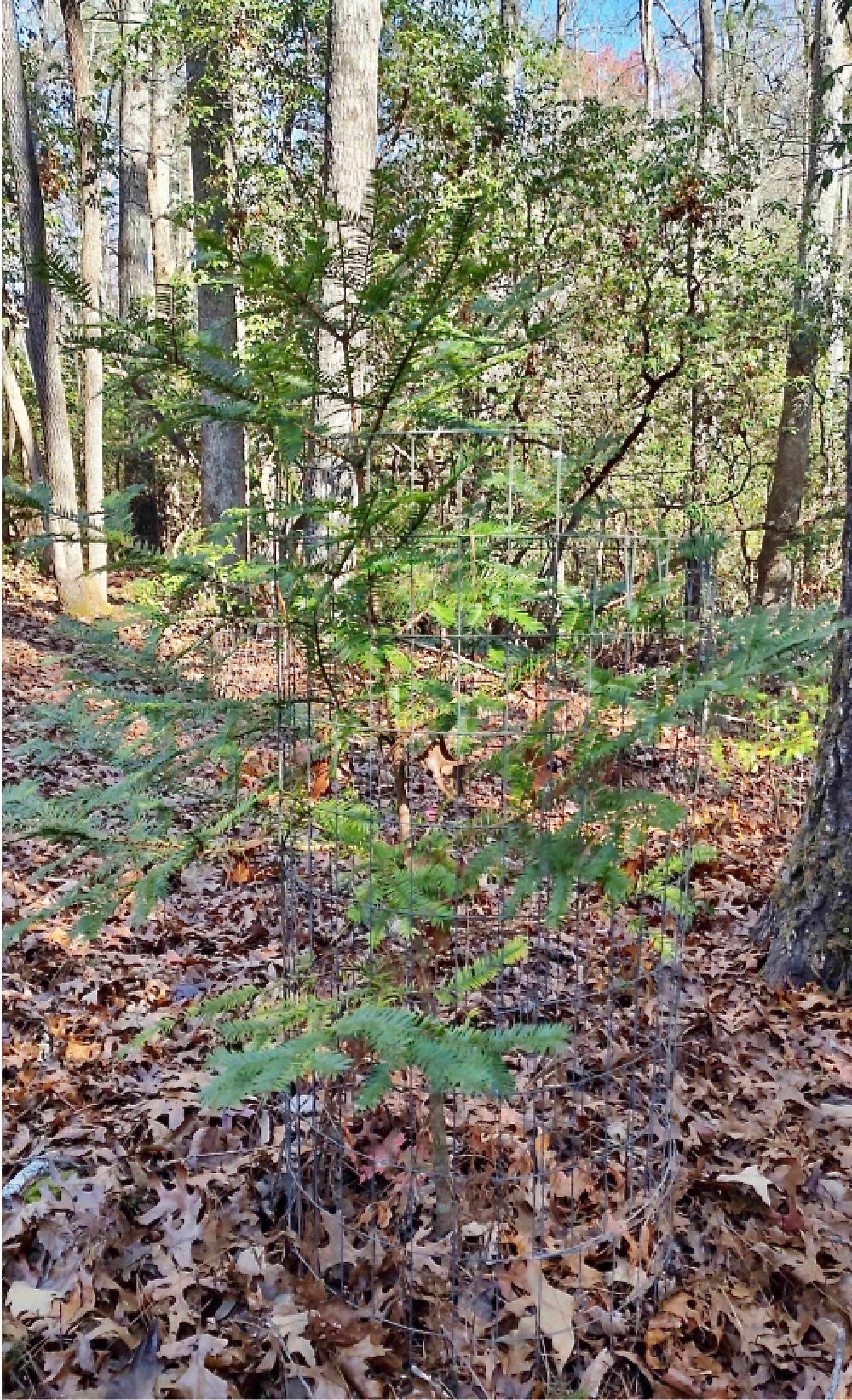
Trees G and I
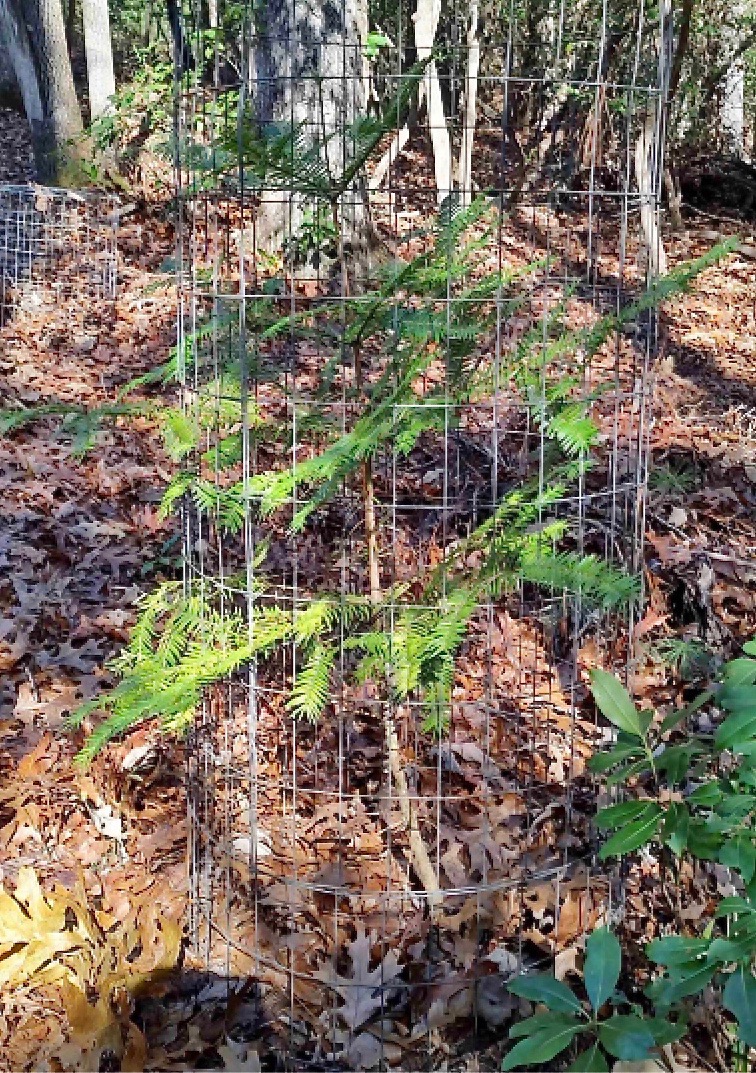
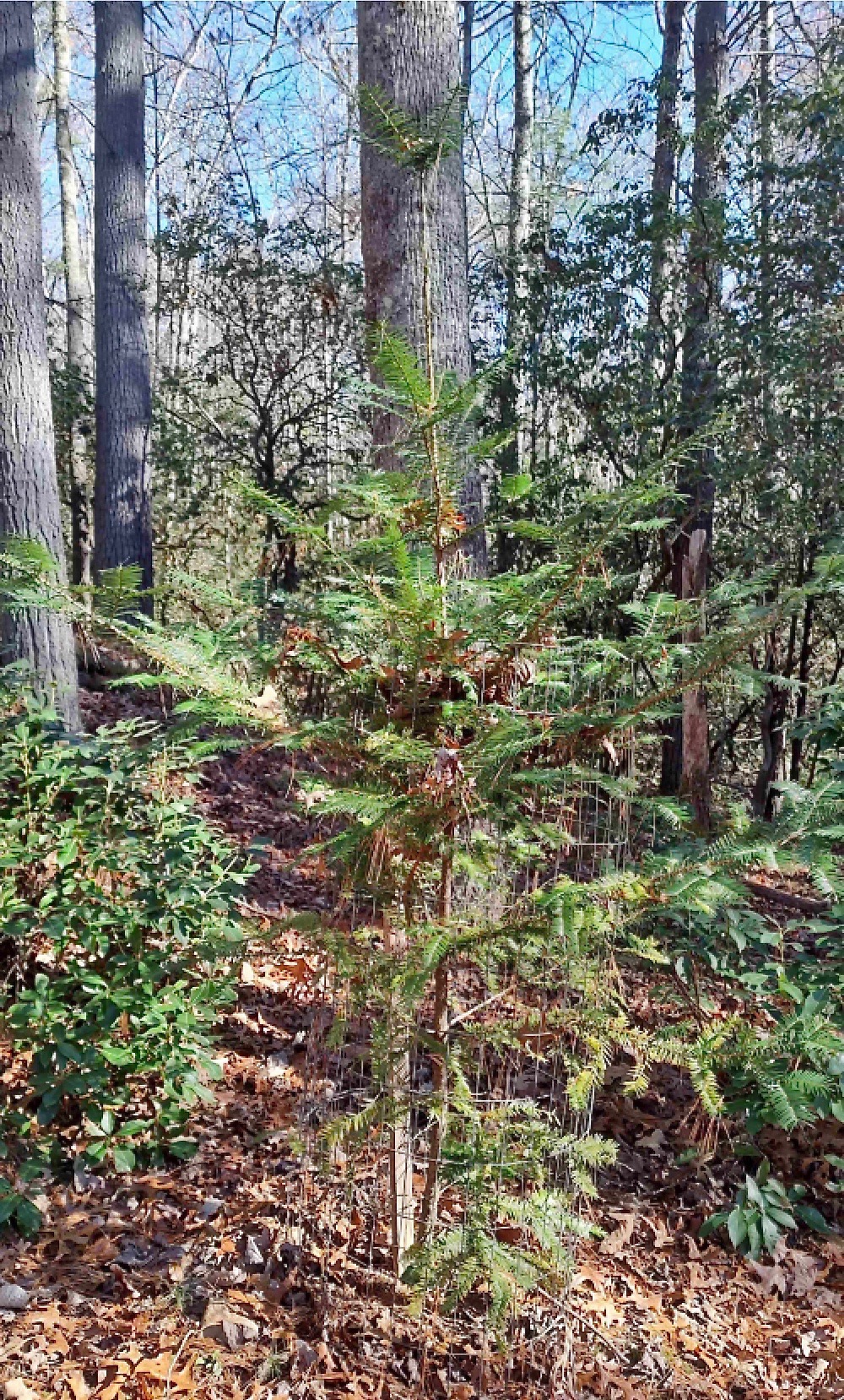
Trees J and K (notice K's super-long vertical growth below top)
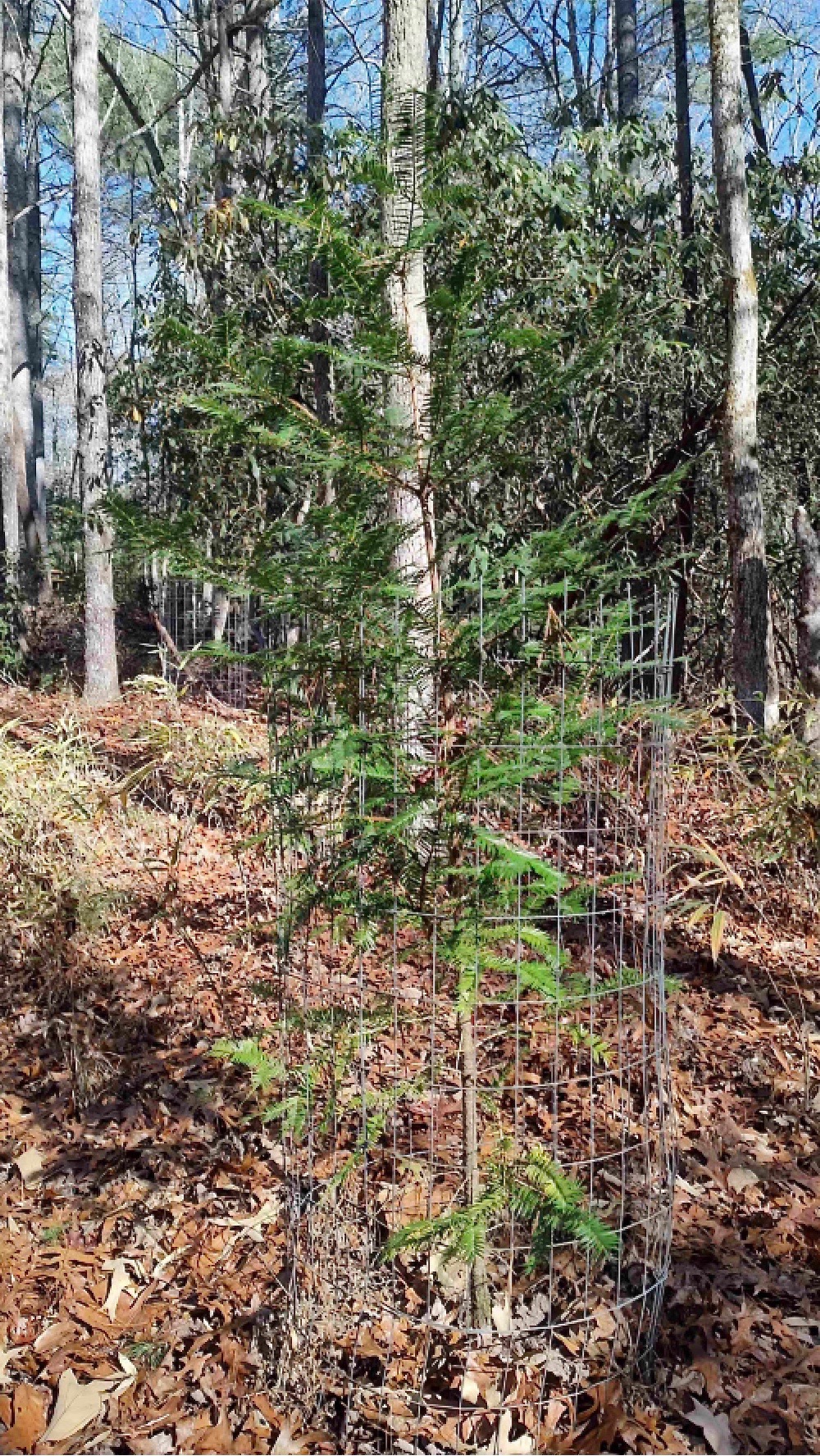
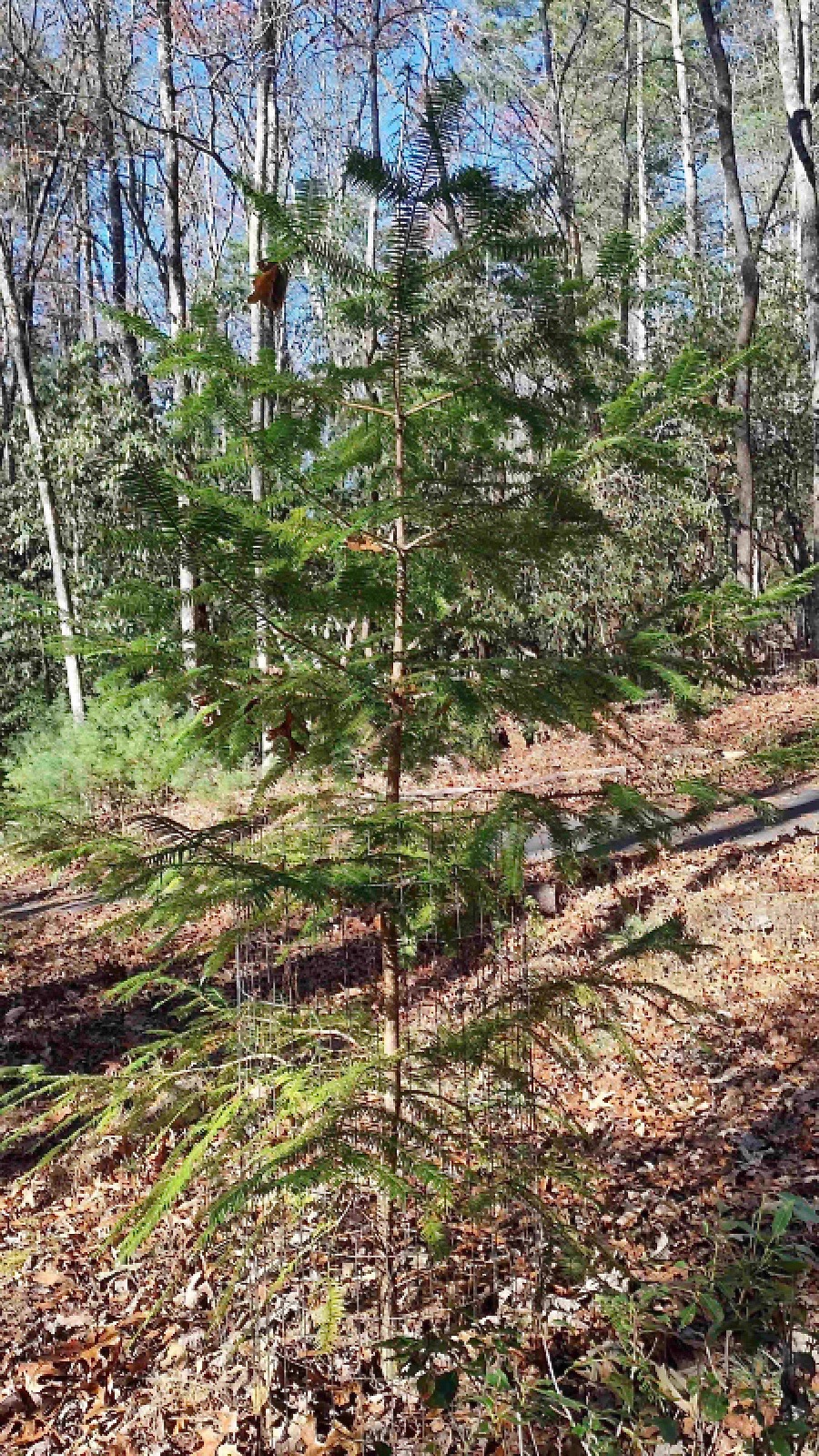
Trees L and M
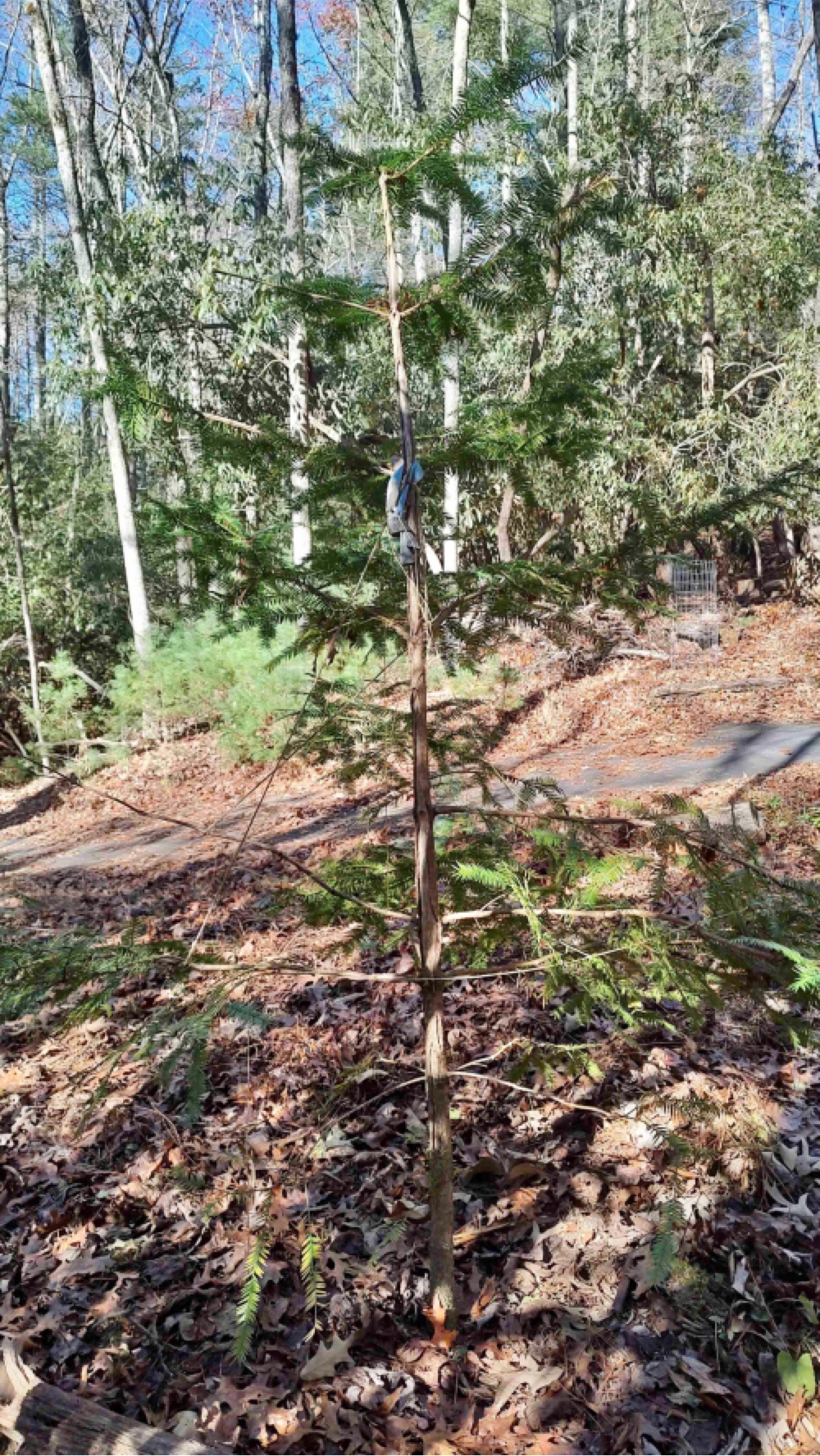
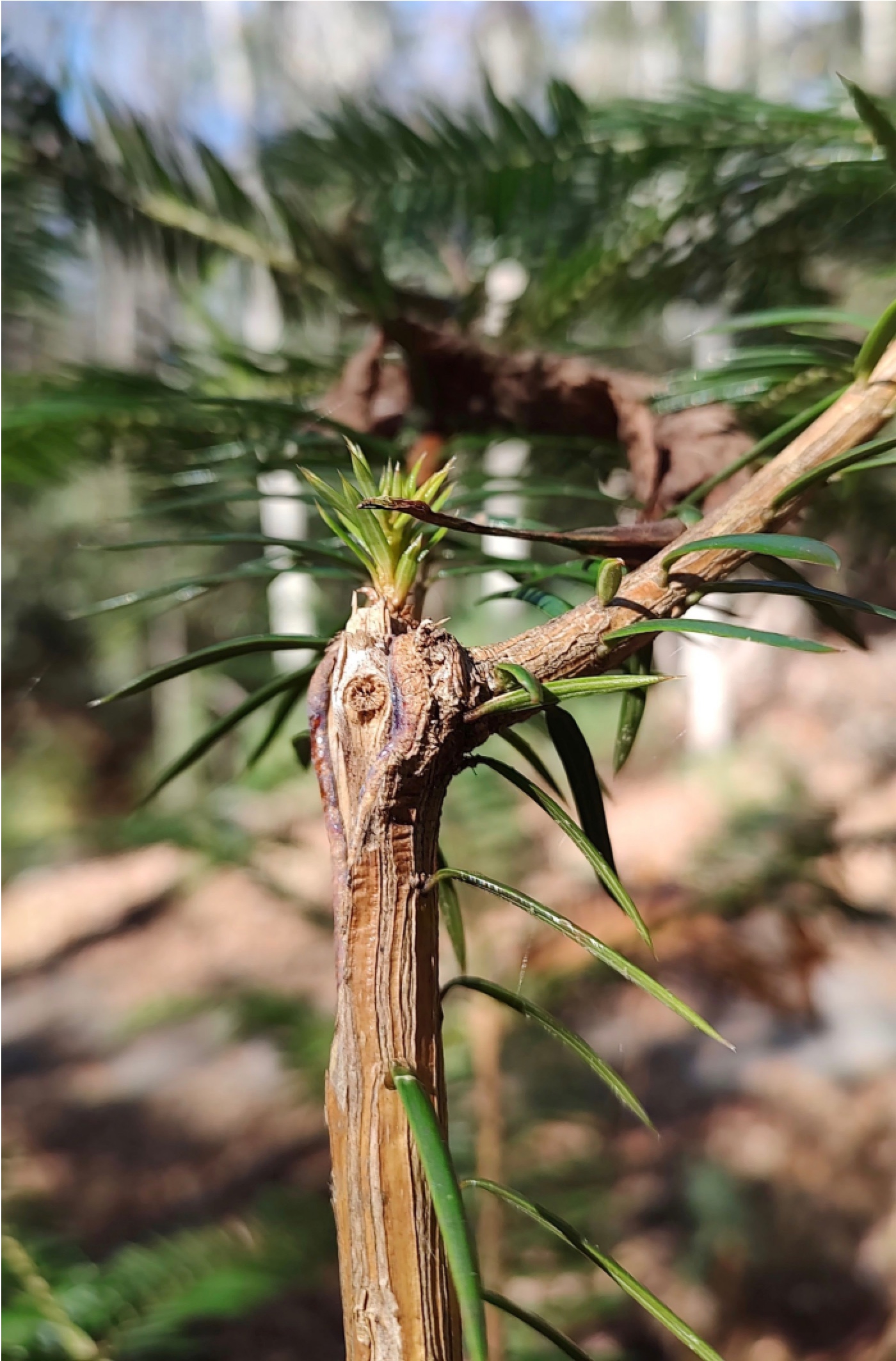
Tree N and its damaged (and regrowing) top
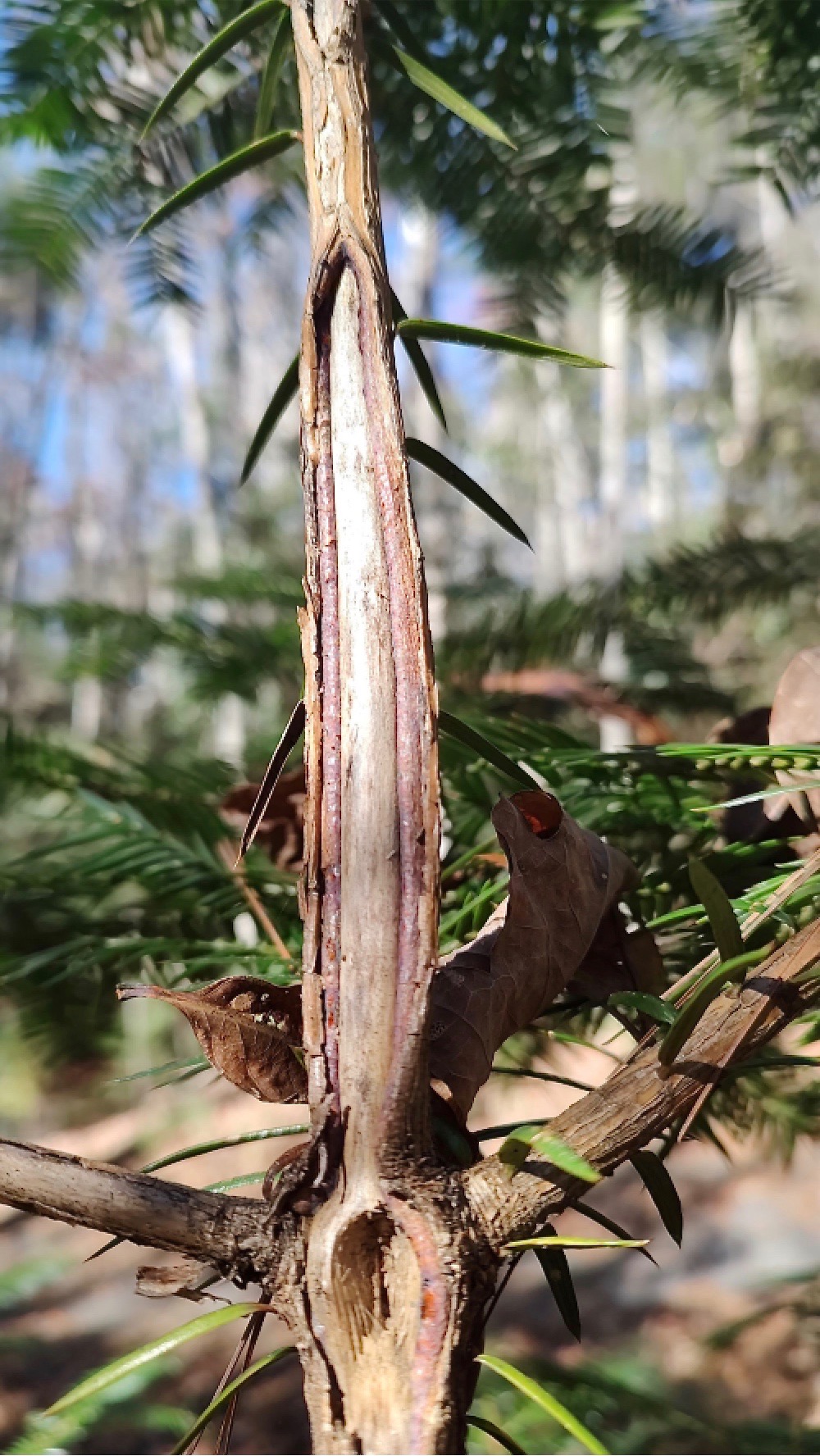
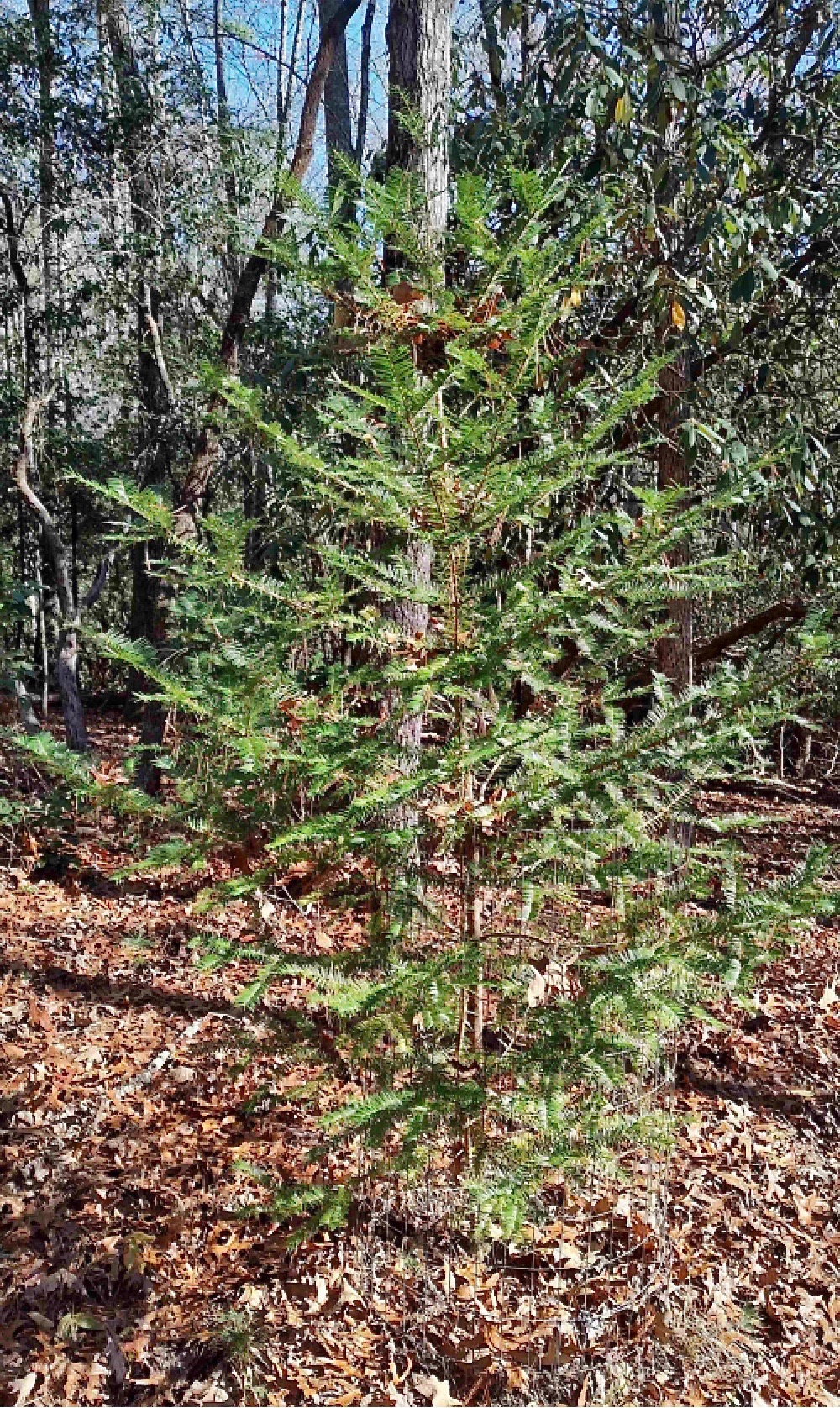
Another damaged part of Tree N and a fully intact Tree R
Over the remainder of the 2024 growing season, the tree healed and its apical meristem branch was replaced by a new bud that I think will become a replacement apical meristem. We�ll see. I decided not to replace the cage, as the branches spread out so much now that a new cage would have to be almost eight feet in diameter. Maybe a buck will further damage it this winter, and maybe not; I consider it another experiment.
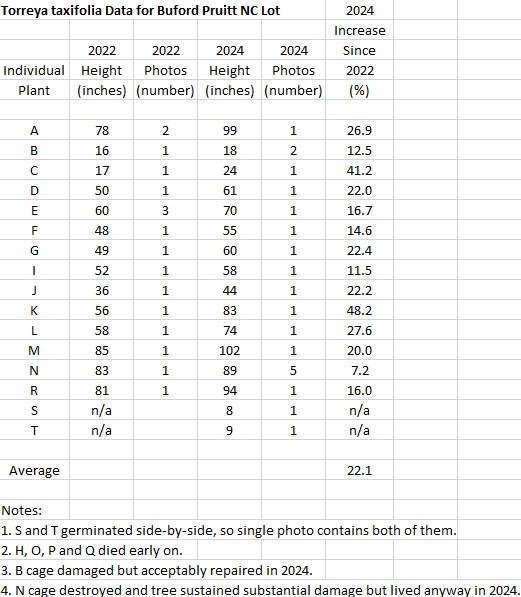
ABOVE: I created an Excel spreadsheet that incorporates 2022 and 2024 height measurements. The 14 trees grew an average of 22.1% over the two years. This value would have been higher if Tree N had not been topped. Notably, trees C and K lengthened over the two-year period by more than 40% each. I am happy with these results.
May 2024
November 2024 ABOVE: Squirrels can be helpful — if one has hundreds of seeds. In 2023 Fred Bess sent me some of his Cleveland OH seeds to be scattered in natural habitat. Some I put 4 to 6 inches deep into the ground and others I merely placed within the leaf litter.
Two of those seeds germinated this year and, as of May 2024, are currently 6+ inches tall (PHOTO LEFT).
They came up at the edge of my picnic table area — way too close to the table for me to have placed them there. So, I believe squirrels found them in the leaf litter and planted them. Since they sprouted only a few inches apart, I decided to let them keep growing together as an experiment. I dug them up in a single clod and transplanted them into a sunnier spot (as seen in the PHOTO RIGHT).
SEE ALSO: See the DECEMBER 2019 entry by Clint Bancroft on his torreya page: evidence that a squirrel carried and planted a seed some 200 feet distant from the seed pot it had worked its way into!
• May 2023 BRIEF NOTE:
"I looked at all my torrey plantings this morning. None show any sign of flowering, although all appear to be very healthy and have put on new growth this spring."• February 2023/ Buford Pruitt / Remembering squirrels are important local seed dispersersBUFORD PRUITT, a wildlife biologist, is a very successful planter of Florida Torreya at his rural home near Brevard, NC. Visit Pruitt's Torreya webpage on this website. This month he contributed a 3-page advocacy essay: "Torrey Squirrels"
DEC 2022 PHOTOS of 14 Torreyas
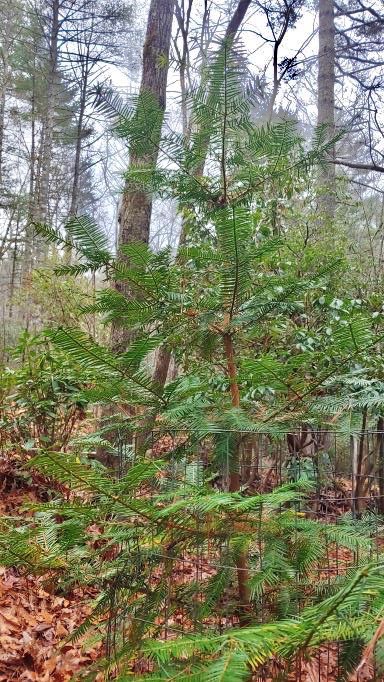
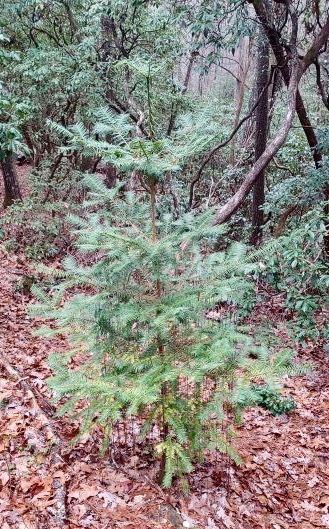
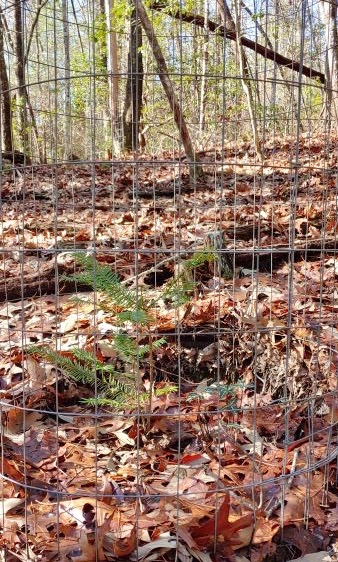
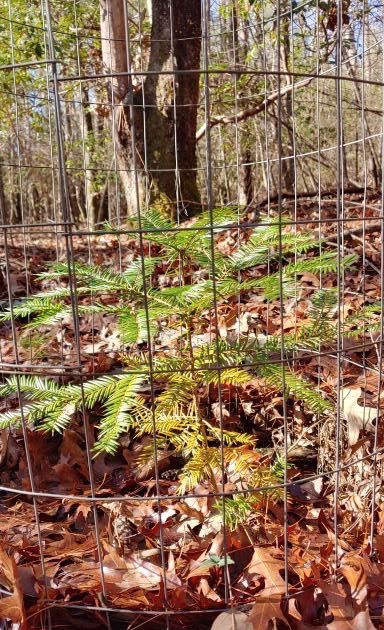
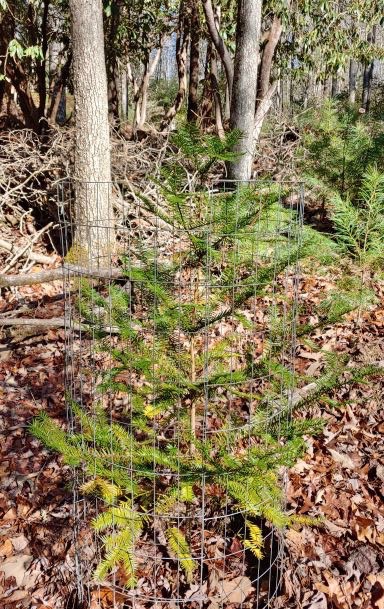
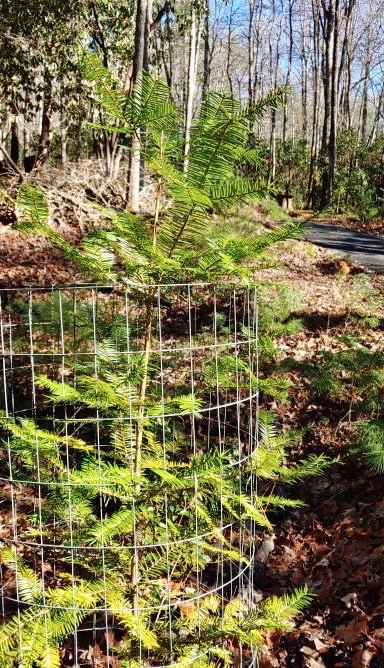
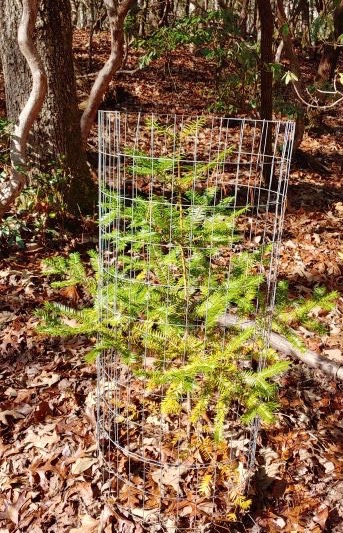
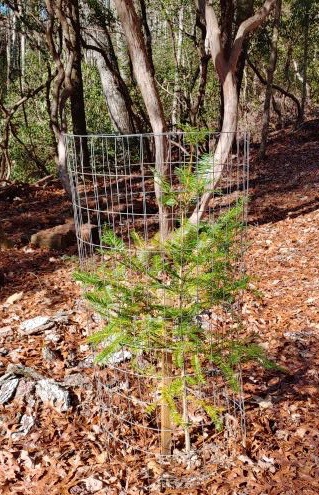
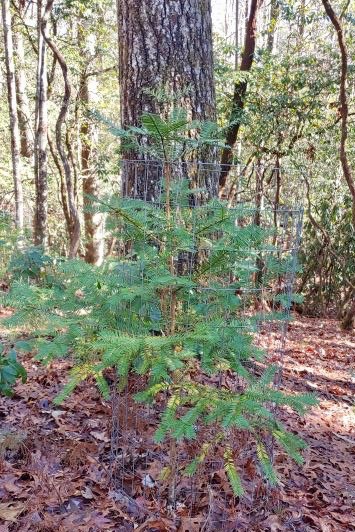
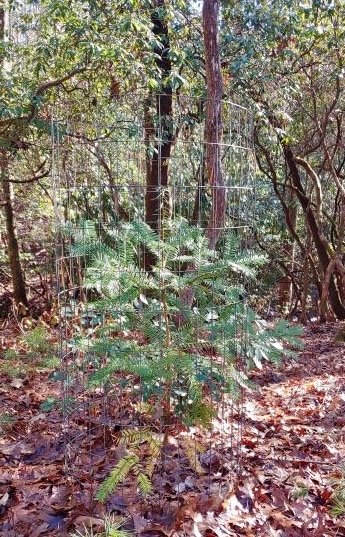
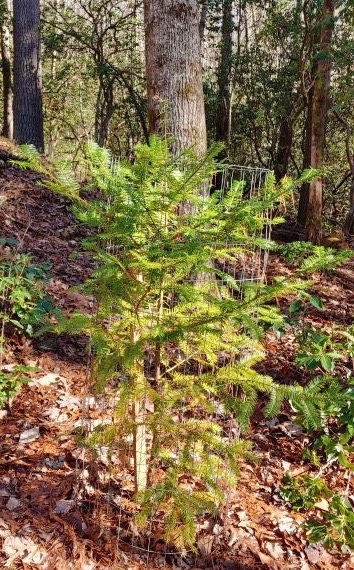
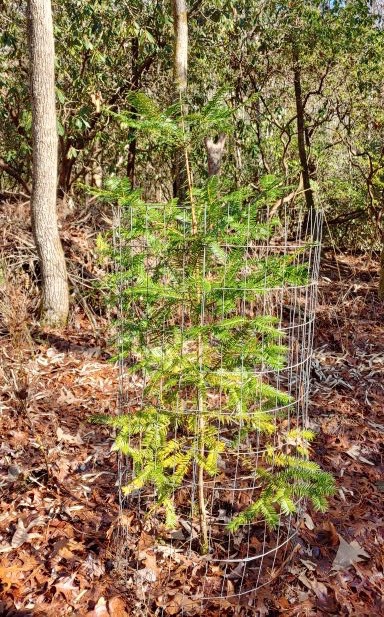
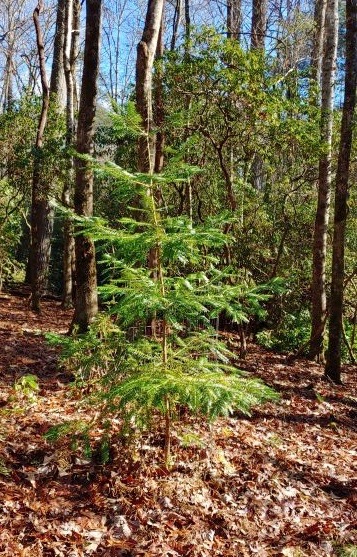
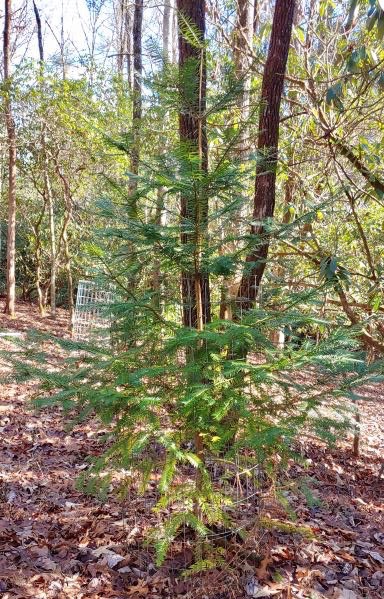
ABOVE PHOTOS (by TREE LETTER): A and A2, B, C, D, E, F, G, I, J, K, L, M, N, R. Pruitt wrote: "It has been a decent year for my Florida torreys. They didn't grow as much as they did last year, but none died and none show significant signs of stress."
COMMENTARY: Buford Pruitt says that the differences in height can be attributed pretty much entirely to the amount of sunlight each receives. All torreyas are still caged, and he places deer-exclusion cages around other woody tree and shrub seedlings that he plants. Buford explains:
"Deer browse all of the oak, magnolia, maple, sassafras, dogwood, redbud, and other seedlings that volunteer at my place. I do not know why deer do not browse the tops and sides of my torreys that protrude from the cages. Perhaps it is because (a) there are plenty of native, natural tree limbs & seedlings to browse on and (b) torreys have wicked needle-tipped branches. Frankly, I am more concerned with male deer rubbing their antler velvet off with torrey stems than browsing, as that is what kills torrey seedlings in my Florida experience... I am thankful that some of the people in my neighborhood hunt the deer in their backyards; otherwise, the area would be overrun by them."He also reports that he does not bud-cap his torreys and that no male or female reproductive buds have yet appeared on any them.
2022 Update on growth differentials and rodent prevention • BUFORD PRUIT writes on 14 April 2022: Voles have not killed any more of my torreys. I totally agree that we should adamantly avoid planting torreys near flat rocks, logs, brush piles, boards, and anything else that might shelter vole nests and burrows. In 2016, after you and I saw the chewed-through taproot of my 15th torrey, I ruthlessly removed all such vole shelter roofs. Subsequently, all 14 of my remaining torreys have survived.
Although the torreys that get little or no direct sunlight are very slow-growing, those that get even only 3+ hours daily of sunlight grew nicely last year. Two or three of them put on a foot or so of vertical growth last year, and they got only 4-5 hours per day of direct sunlight. The occasional heavy snows and ice storms haven't fazed them.
The only wildlife problem I have had in the last several years with torreys is deer and maybe some other good-sized mammals (e.g., coyote, dog, black bear). They go running through the woods in agonistic responses to unknown stimuli (e.g., mating, predators, predation, playing) and blunder into the torrey cages, knocking them down and warping them pretty good! However, I just remove and repair the cages and then put them back around the torreys. In another year or two it happens again with a different plant, which tells me the animals weren't deliberately trying to get at the torreys. Falling tree branches and limbs have the same effect.
[RE: Jack's recommendation on adding gravel when out-planting potted seedlings]: I had not thought of graveling around the root ball [to deter burrowing rodents]. My guess is that (1) it won't harm the torrey at all (lots of rocks already in the ground here), (2) rodents certainly don't want to try to chew through hard rock, and (3) if the rock type is carefully chosen, it might even add nutrients in low supply in the host soil. As examples, limestone would provide Ca/Mg and raise the pH favorably, and greenstone could provide K. I wish now that I had brought some limestone back from FL this past Feb.
As for WHAT I WOULD RECOMMEND TO OTHERS: (1) deer exclusion cages, (2) away from vole shelter features, (3) gravel + monitoring. I am ambivalent about enclosing the root ball in hardware cloth because I am uncertain about (1) how long it would take for the steel to deteriorate sufficiently for torrey roots to elbow the mesh apart as the torrey roots thicken, and (2) my torrey's success versus voles when I removed the remaining vole shelters, and the torreys simultaneously putting out multiple horizontal roots faster than voles can eat them (arms race).
Your note re Asarum co-planting is very interesting. I would love to read about such experimental results.
2022 Details on Torreya Growth Forms and Buck Deer Protection • BUFORD PRUIT writes on 8 January 2022: Family groups of deer come through my lot several times a day. Only a few minutes ago, a doe and her three young-of-the-year came foraging. Plus, there's a second doe with two young-uns, a third doe with one young, and a pair of spike bucks (brothers?) that browse through daily. Rarely, I see an 8-point buck foraging through. As I write this, a solo doe is right now browsing through. Deer eat all the seedling oaks, sourwoods, dogwoods, hickories, Franklinias, and tulip poplars, so the only significant tree regeneration here is with white pine and a few tulip poplars. Deer even eat the pink lady slipper orchid leaves when all other greens are gone.
I put exclusion fencing around all my woody plantings (blueberries, serviceberries, hazelnuts, redbuds, etc.) or else they would be nibbled to nubbins. This is a consequence of deer overpopulation, which is a consequence of little to no predation. In addition to the 14 torrey ex-fences, there's another 17 woody plants with ex-fences scattered around the sunny portions of my lot.
I doubt that the deer would browse the torreys, as they don't do so on pines and hemlocks. Also, my bucks don't know how good torreys are for antler rubbing because they have never had any to try out, and I'm not going to give them the opportunity, either. All or nearly all of the small torreys I have seen in FL parklands have been deer-rubbed. This either killed the trees or left them with gaping wounds (portals of entry) that allowed pathogenic organisms to become established. I would say that bucks will do this to basically all torreys having caliper diameters of an inch or less. Therefore, until they measure two inches or larger in dbh, my ex-fences will remain.
Most of mine are fast-growing because they are planted where they get 3-5 hrs per day of direct sunshine. They put on 6-12 inches of height every year as they reach for the sun. However, as the lower limbs continue to grow, they "flesh out" the tree. Those planted in forests don't get enough sunlight to grow fast, so the ones I have seen in NC forests are indeed leggy.
Trees planted in wide open spaces like pastures and suburbs get so much sunlight that they don't need to grow tall; they instead grow wide with dense foliage. They typically have shorter main-stem internodes and thus look "fuller." You [Connie Barlow] and I have corresponded about this before. Remember, my degree is in forestry and wildlife management. I know about trees and deer. I think the bottom line here is that you yourself have called my torreys the best TG torreys in North Carolina.
2021 Status of 14 Torreyas • BUFORD PRUIT writes on 2 September 2021: "My torreys are doing very well. Three are now six feet high or taller. Almost all put on new growth last year, and several put on two flushes of new growth. This year, they put on one flush of new growth, but none did so twice. All are within deer exclusion cages. One has a side sucker 2+ feet tall. I'll photo-document them all for you this fall after the growing season ends."
2020 Status of 14 Torreyas
• BUFORD PRUITT writes: The 14 Florida torreys that you saw the last time you were here [May 2016] are doing fantastic. They have outgrown the voles and several grew a foot or more last year & have put on even more growth this year. All seedlings are protected from deer-rubbing by being enclosed in 2-3 ft diameter x 4 ft tall, 2x4 wire fencing. This was done to prevent the most common cause of torreya seedling demise in Florida — namely, from severe damage to 4-6 ft tall stems and bark caused by deer rubbing off their antler felt in late summer.
PHOTO LEFT: Seedling A was germinated from 2009 seed placed in a 2 ft x 3 ft x 6 inch wood box where it spent the winter. It was the only seed that germinated from 10 seeds provided. It was transplanted in the spring of 2010 into a 1 gal pot containing potting soil. Later that year, it was transplanted to a 3 gal pot. It was finally planted in the ground in 2011.
It gets about 3 hrs/day of direct sunlight in the middle of the day and variable amounts of partial sunlight otherwise.
As of December 2020, it had grown to a height of 59 inches.
BELOW ARE PHOTOS AND STATS OF THE REST OF THE 14 TOTAL TORREYAS PLANTED IN REGROWTH FOREST — all from seeds harvested either autumn 2010 or 2011.
• Seedling B (ABOVE LEFT) was germinated from 2010 seed in 1 gal pot containing potting soil and planted in the ground in 2011. It is planted at the edge of my driveway within mature natural forest where it gets maybe an hour of direct sunlight per day. It is also in the driest location of all my torreya seedlings. As of December 2020, it had attained the height of 16 inches.
• Seedling C (ABOVE RIGHT) is the shortest of all. It was germinated from 2010 seed in a 1 gal pot and planted in 2011. It is within mature natural forest and gets no direct sunlight. As of December 2020, it had grown to a height of only 13 inchess.
• Seedling D (ABOVE LEFT) was germinated from 2010 seed in a 1 gal pot and planted in 2011 at the edge of my driveway within mature natural forest where it gets 3-4 hours of direct sunlight per day. As of December 2020, it had grown to a height of 43 inches.
• Seedling E (ABOVE RIGHT) was germinated from 2010 seed in a 1 gal pot and planted in 2011 at the edge of my driveway within mature natural forest where it gets 4-5 hours of direct sunlight per day. As of December 2020, it had grown to a height of 53 inches.
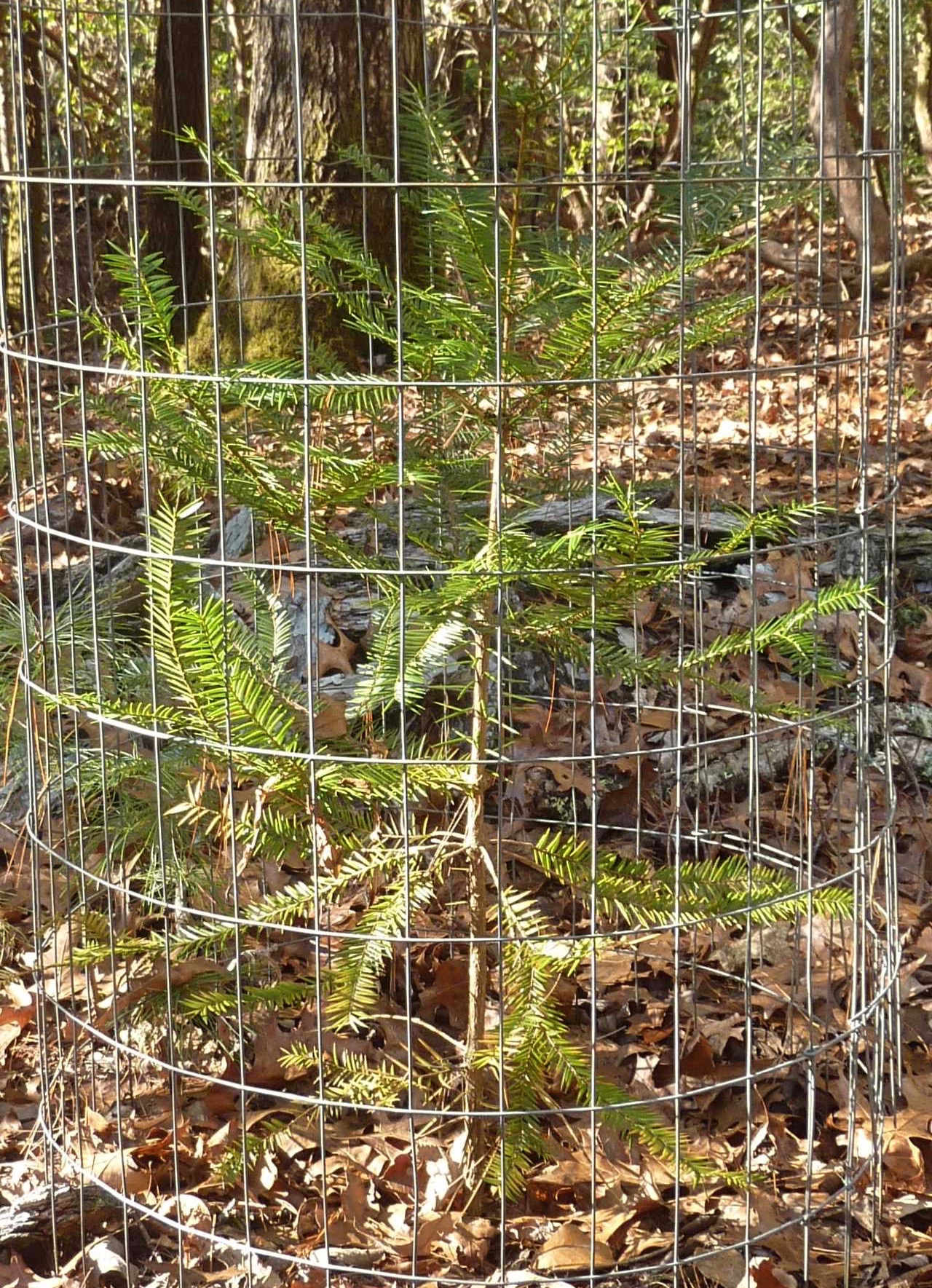
• Both Seedling F (ABOVE LEFT) and Seedling G (ABOVE RIGHT) were germinated from 2011 seed in 1 gallon pots and planted in 2012 at the edge of my driveway within mature natural forest. Each gets 2-3 hours of direct sunlight per day. As of December 2020, F had grown to a height of 33 inches and G to height of 34 inches.
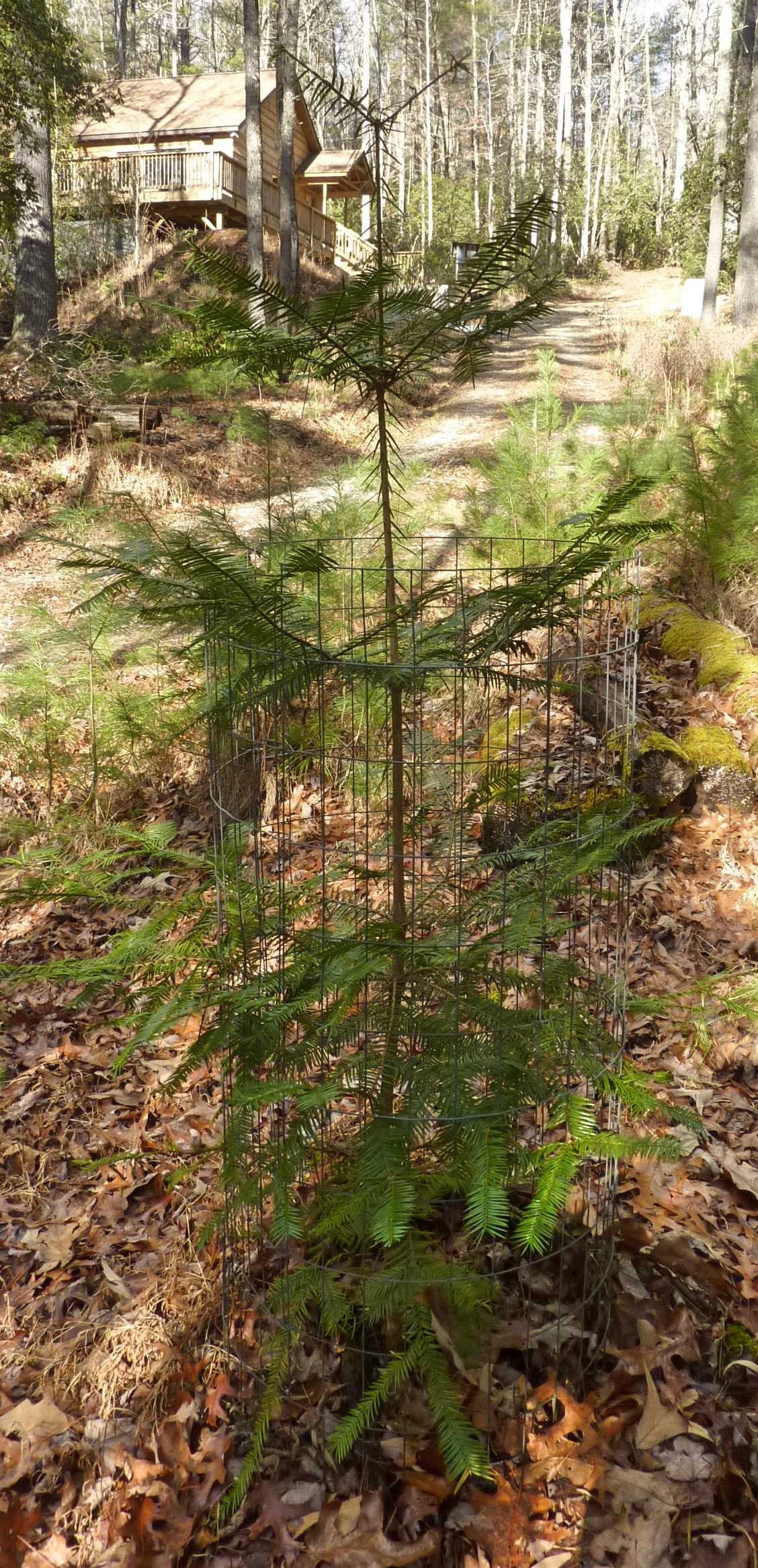
• Seedlings H, K, and M ABOVE were all germinated in 1 gallon pots from seeds harvested autumn 2011. They were outplanted into protective cages at the edge of the driveway in 2012. Stats on each: H gets 3-4 hours of direct sunlight daily and is 44 inches tall. K and M both get 4-5 hours of direct sunlight daily and both are 71 inches tall — the tallest of all 14 torreyas).
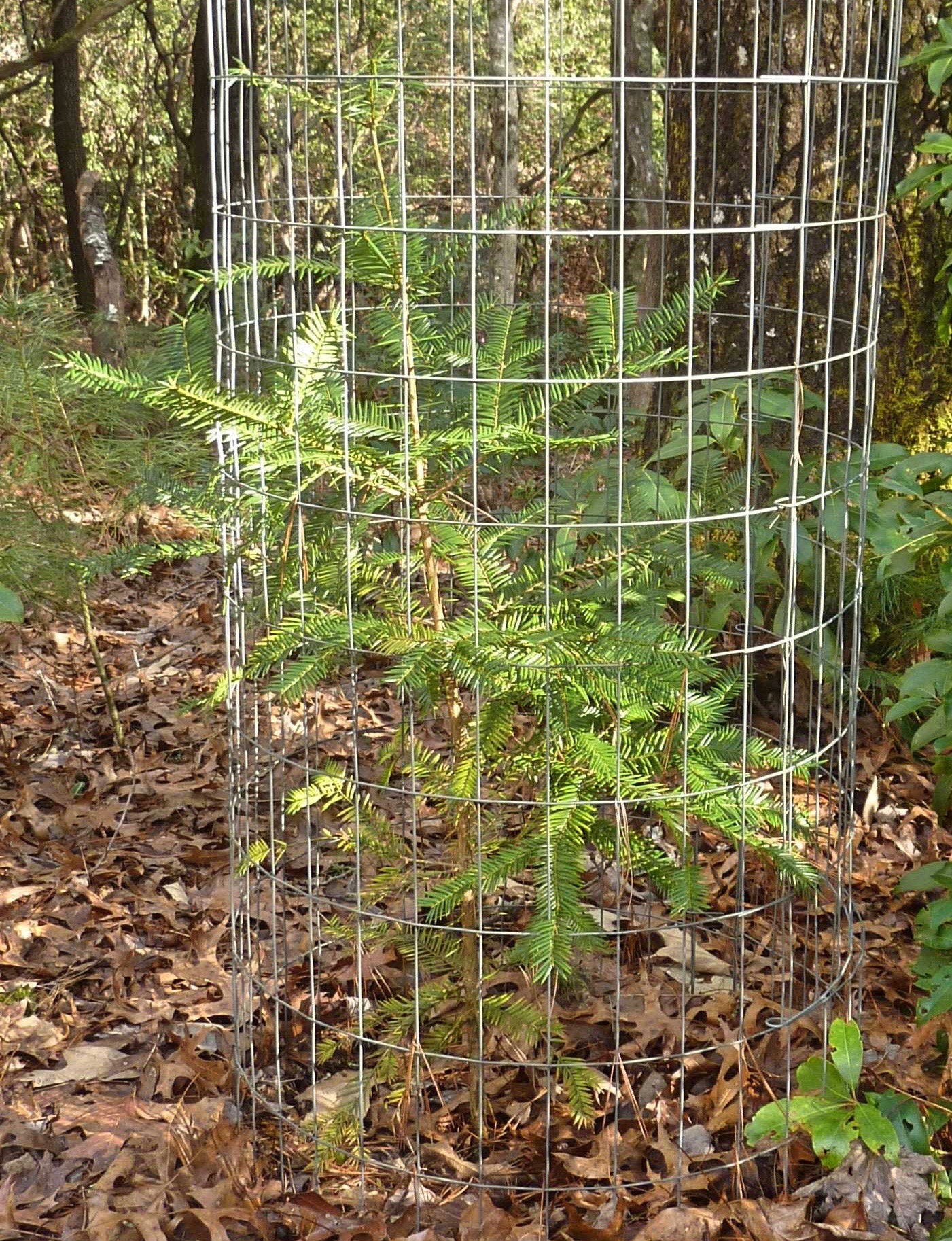
• Seedlings I and J (ABOVE) were germinated in 1 gallon pots from seeds harvested autumn 2011. They were outplanted into protective cages inward 15 to 20 feet from the edge of the driveway (into mature forest) in 2012. Seedling I gets 1-2 hours of direct sunlight daily and is 31 inches tall. Seedling J gets less than 1 hour direct sunlight daily and is 40 inches tall.
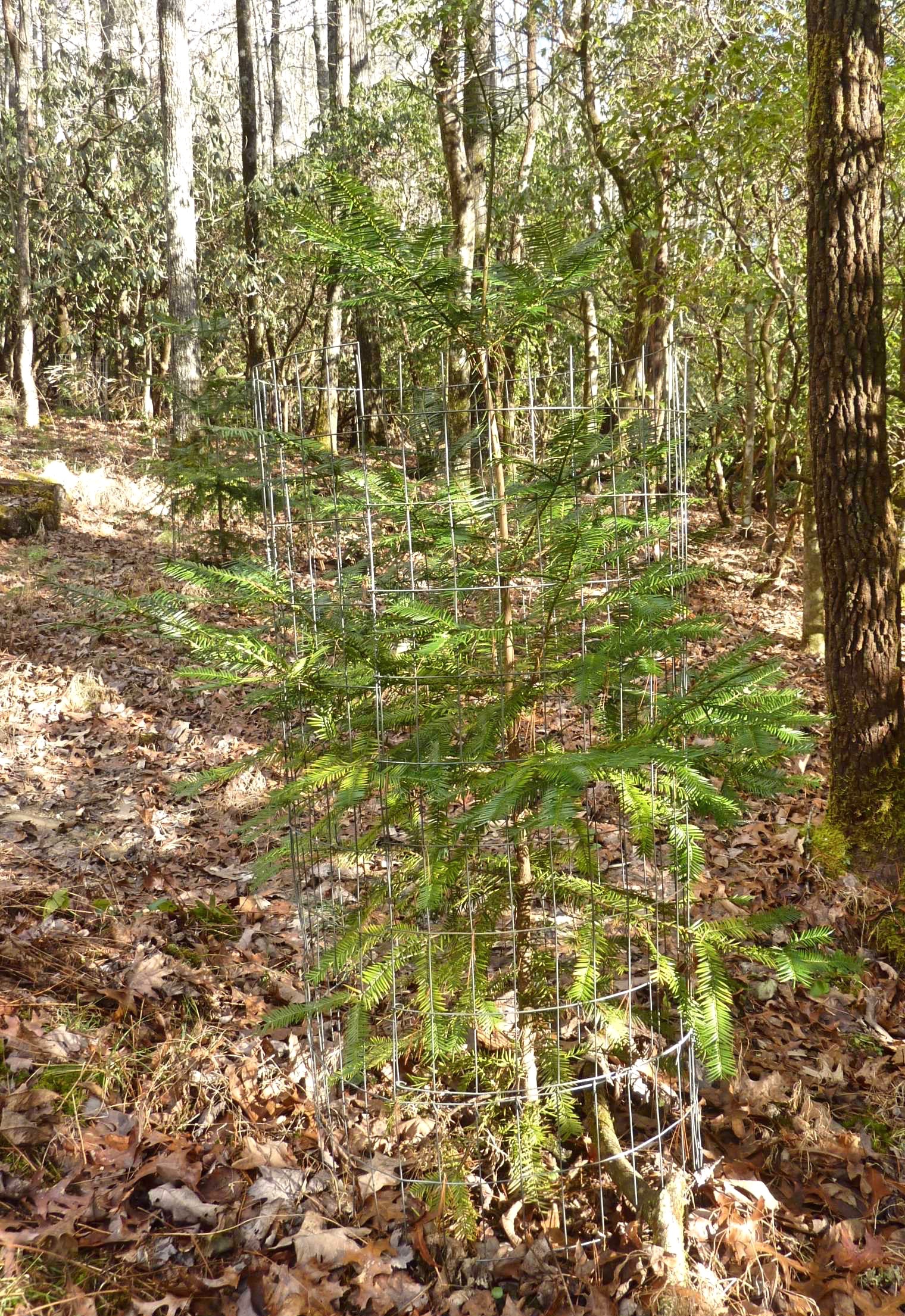
• Both Seedling L (ABOVE LEFT) and Seedling N (ABOVE RIGHT) were germinated from 2011 seed in 1 gallon pots and planted in 2012 at the edge of my driveway within mature natural forest. Each gets 4-5 hours of direct sunlight per day. As of December 2020, L had grown to a height of 46 inches and N to height of 62 inches.
Torreya Seedling Status as of May 2016 Video report posted on youtube of trees in Brevard NC
19a: Florida Torreya to Brevard NC: 2016 Report Buford Pruitt leads Connie Barlow on a video tour of his 17 Torreya taxifolia caged seedlings, planted in partial sun offered by his homesite edges in a regrowth forest near Brevard NC. Significant findings: Watch an "autopsy" of the one plant that died during the winter, and see evidence rodent predation of roots and lower bark. Learn how to assess plant vigor and important measurements to record. Notice the "basal sprouts" and why they should never be pruned back. Buford's trees are all from 2010, 2011, and 2012 Torreya Guardians seed harvests.
45 minutes - filmed 25 May 2016
19b: Florida Torreya to Brevard NC: 2016 Report The last half of Buford Pruitt's tour of his 16 still-living caged seedlings. Three apparently are planted on the compacted soil of an old logging road, and are struggling. Connie steers a discussion of the overall forest health: Why is there so little greenery on the forest floor? Pieced in are video segments of the lush greenery surrounding the original torreya plantings at the Waynesville site, 700 feet higher in elevation and on a far steeper (never cattle-grazed?) slope. Overall, this 2-part series is a superb video for all new Torreya Guardians to watch — in order to help them assess their own properties for where best to plant seedlings.
35 minutes - filmed 25 May 2016
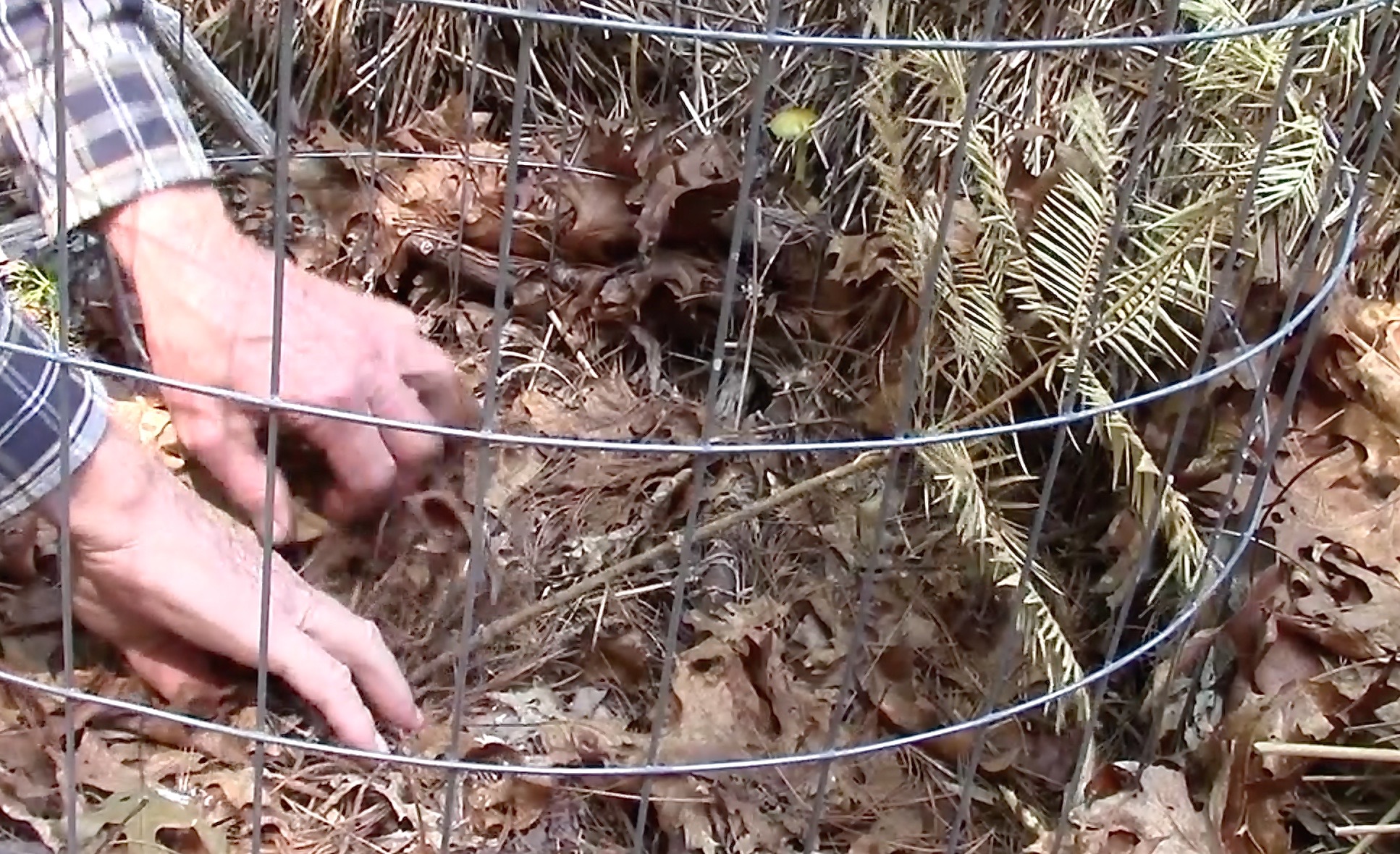
PHOTOS ABOVE: These are stills taken from the video 19a above. They show how a once-healthy planting can suddenly die — owing to a rodent tunnel that is clearly chimpmunk-size. See how the roots and the living bark have been entirely gnawed away. Notice the light-colored pellets in the root photo; these are perlite. See the editor's note directly below about the importance of shaking out the perlite to deter rodent burrows! Also, in the video itself you will hear Connie remarking on the unusually compact soils and impoverished forest understory (probably owing to excessive cattle pasturing in the past). Perlite + surrounding packed soils we now know will vastly increase the rodent herbivory prospects of even carefully tended outplantings.
Editor's note: Thanks to our New Hampshire Torreya Guardian, Daein Ballard, we can now suggest that care must be taken to shake out perlite and loose soil from the roots of potted seedlings prior to planting outdoors. Chipmunks will be enticed to build their winter burrows in the loose soil (and therefore snack on the roots too) — especially if the natural soil in the surrounds is inferior or has a clay pan barrier to digging. The same goes for mulch: Mulch around the base of a torreya will also attract burrowing rodents.
VISIT THE RODENT SECTION of our "Propagate page" for more details on how to deter rodent herbivory.
Torreya Seedling Status as of Summer 2015 Buford Pruitt report of May 2015: "I am happy to report the seedlings are doing very well. None of them were killed by anything during the winter and all appear healthy and have new branch-tip shoots."
PHOTO BELOW LEFT shows the new growth on the largest and oldest seedling (2010 seed), which is the one that I transplanted last summer. There is no indication that the transplanting harmed it. Most of its top branches have 3 new shoots and the others have 2; lower branches have 1 shoot each.
PHOTO BELOW RIGHT shows the same seedling from the side looking west. Counting 6@ 4" wire spaces = 24", plus 2" outside the 6 spaces = 26" height. That's approx. 5.2 inches per year of vertical growth. You can see that the branches grow all around the stem, despite being at the edge of a shady forest. It gets about 3 hrs of direct sunlight daily from about 10:30 to 13:30 hrs, plus filtered sunlight another 3+ hrs.
Torreya Seedling Status as of Summer 2013
Buford Pruitt's July 2013 blogpost is a great SUMMARY REPORT OF RESULTS THROUGH JULY 2013. It has been copied, with photos, directly below also: STATUS OF 2010 SEEDS: Only one of ten Torreya seeds from the 2010 crop given to me ever sprouted. It was a disappointing result, and other Torreya Guardians had a similar lack of success. Nonetheless, my single seedling grew vigorously, growing six inches the spring of 2012 in (a pot in) Florida. It grew another two or three inches in the first three weeks in the pot at my North Carolina home, was planted in the ground in Brevard NC in May, and at this writing is 21 inches tall (see photo left). I think it likes it here in the Southern Appalachians.
2014 update "Connie Barlow wrote about torreys growing next to white pines. My largest in-ground torrey was adjacent to white pines and was flourishing. I transplanted it a few weeks ago (further away from pines) because a large white pine needs to be timbered and would have crushed the torrey coming down. Some of my other torreys are planted close to white pines. Interesting connection: torrey and white pine. Will think on it."
STATUS OF 2011 SEEDS: My 2011 seeds started off rather slowly. None germinated the following spring in Florida, and only three sprouted in July 2012, in North Carolina. Other Guardians reported similar results, and it looked like a repeat of the 2010 track record.
But after only a month following their return to north Florida, in December 2012 another four seeds sprouted, in January 2013 another germinated, and the ninth seed germinated in February 2013. That yields a 90% success rate for the 2011 seeds, and again other Torreya Guardians enjoyed a similar pattern of delayed but successful germination. I gave two of my 2011 seedlings to my gardening friend Brack in Williston, FL, and planted another three (height range 9-10 in) at my NC place during the last three weeks.
DEER EXCLUSION CAGES: In case you are wondering about the deer exclusion cages, they are constructed of 2x4 inch mesh, 4 ft tall, 1.5 to 2.0 ft diameter galvanized steel fencing, and set a couple of inches into the ground so that roots will grow over the bottom wires to hold them down. Editor's note: At the Waynesville and Junaluska NC sites, where 31 Torreya taxifolia seedlings were planted in the summer of 2008, no deer exclusion cages were ever constructed and no deer herbivory or antler-scraping problems have yet developed (as of 2013). However, at the historically native range of T. taxifolia in and nearby Torreya State Park (along the Apalachicola River of northern Florida), deer exclusion cages have been adopted as an important aspect for nurturing the continued survival of the species there.
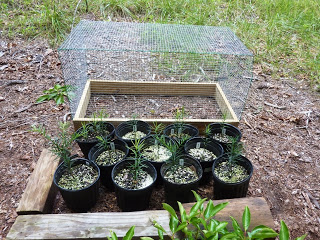
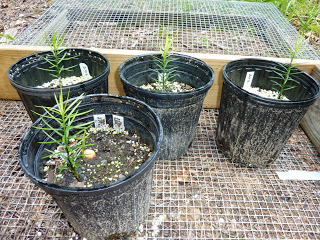
RODENT EXCLUSION CAGES FOR 2011 GERMINATED SEEDLINGS STILL IN POTS: See photos above of my 4 2011 seedlings (height range 6 - 13 in) that are remaining to be transplanted; they are in pots protected by rodent exclusion cages.
Those cages also contain 15 seedlings from the 2012 crop of 20 seeds given to me. The 2012 seeds were small, pale floaters — quite unlike the larger, darker, denser 2010 and 2011 seeds. I planted 4 to a 1-gal pot (previous years had 2 per pot) in Florida. By late April, 4 of them had sprouted and were growing vigorously. Shortly after moving from Florida to North Carolina, a flush of 8 sprouted during early June 2013 and another 3 have sprouted since then. That totals 15 sprouted seedlings from the 2012 seeds, or 75% success rate thus far.
BUFORD PRUITT reports (Aug 2013) on the status of the 2012 harvest seeds he is trying to germinate:
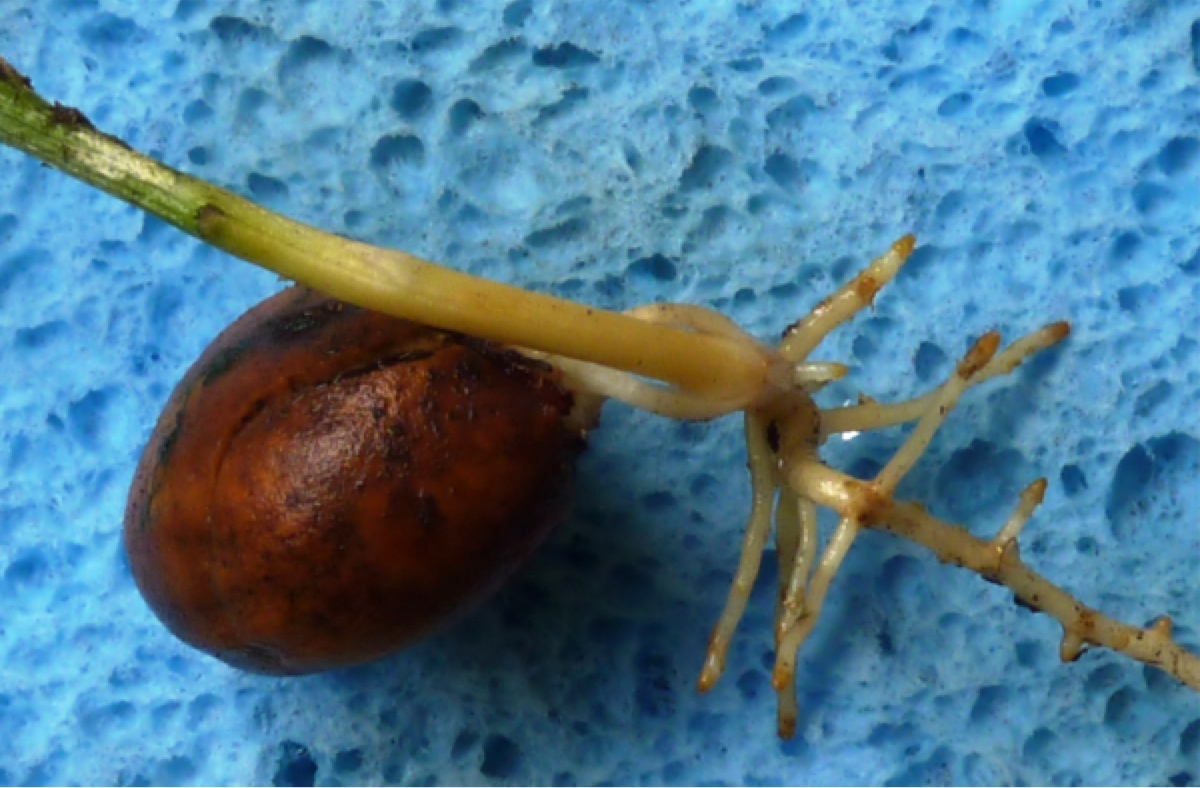
TOP TWO PHOTOS LEFT: "Here are two photos of damage to two growing tips of a germinating Torreya seed. I guess they are roots, as I seem to remember reading that roots are the first meristems to sprout from Torreya seeds. The tips of the two growths were found to be damaged when I dug the seed up this morning, even though I was careful not to damage it myself. It looks like the tips have been eroded away rather than chewed off. Nematode damage is often presented as occurring within nodes along the length of roots, so I don't suspect nemas as the culprits." UPDATE: "Today I took apart my two remaining 4-seeded 2012 pots. Each had two healthy seedlings and two unsprouted seeds. I re-potted the four seedlings into fresh potting soil and set them back under the hardware cloth. Both of the first pot's unsprouted seeds had in fact germinated, but their growing tips were abraded off like the one I reported Saturday. There was an ANT NEST in that pot, and I saw an ant and an ant larva nestled within the remaining limbs of one of the sprouts. It appeared to me that the ANTS had chewed off the growing tip, arresting its growth, which I suspect will kill the seed. One of the other pot's two unsprouted seeds had not yet germinated, which I planted in its own pot, and the last seed was a repeat of the first two.
In summary, ANTS OR ANOTHER UNKNOWN AGENT infested three of five 1-gal pots and killed 4 of 19 sprouting seeds, for a 20% rate of mortality. This pest reduced my germination success from 95% to 75%.
PHOTO ABOVE LEFT: "Look at the attached photo of a normal, healthy seedling sprouting node. You can see the dark seed, the leafstalk extending out to the upper left, the roots to the lower right, and a vague node from which radiate the roots, leafstalk, and twinned stalks that connect the node to the seed. Evidently, from the seed first emerges a twinned stalk about a quarter-inch in diameter that grows about a half-inch horizontally and then makes a 90-degree bend downward that extends another half-inch or so. From the tip of the twinned stalk then emerge numerous roots that grow outward and downward from the exterior of the node, and a leafstalk that emerges from between the two sides of the twinned stalk and grows straight up. Because both the leafstalk and roots emerge from the node, I'm not sure that what first sprouts from a T. taxifolia seed is technically either a root or a shoot.
PROGRESS REPORT: I now have five 2011 seedlings in the ground (in Brevard) in addition to the sole 2010 seedling. Based on previous experiences of TGers, I have not planted any under a full forest canopy. All are at edges of openings in the forest where they will get several to many hours of direct sunlight each day.
SUMMARY: My Torreya seeds tend to sprout in flushes of three or more at a time, and they tend to do so shortly after I move from Florida to North Carolina in the spring and then back to Florida again in autumn. It will be interesting to see if any of the five as-yet unsprouted 2012 seeds will germinate when I return to Florida in November this year (2013).
November 2014 update" See Buford's November 2014 blogpost on his Torreya trees in Brevard NC. He reports that 18 Torreyas are now in the ground (see lots of photos of his method and deer exclusion fencing). He wrote: "I have almost maxed out the number of Florida torreyas (Torreya taxifolia) that can be reasonably planted at my North Carolina home. Eighteen are now in the ground, mostly along both sides of the driveway and a few around the edge of the yard. One is from the 2010 seed crop, five from the 2011 seed crop, and the twelve planted this year from the 2012 seed crop. My previous torrey blog posts document the first six (2010 + 2011) that were transplanted into the ground in past years, and the present post documents the last twelve."
Late January 2013 update on receiving 10 seeds from the autumn 2011 harvest: Buford reports that 8 of the 10 seeds have now germinated. See his early January 2013 blogpost reporting the timing and conditions of the first 7 of the 10 seeds to germinate. As of February 2013, 9 of the 10 seeds have germinated. See his blogpost with photos.
His November 2012 blogpost on receiving 20 seeds from the 2012 harvest.
October 2012 update on the Brevard Torreyas, by Buford Pruitt: "The single seedling that germinated from the ten seeds I received from the autumn 2010 harvest has grown another 8 inches since I last wrote about it. It now stands 20 inches tall in the ground in the NC mountains."
August 2012: As of August 2012, only one seed (of 10 he received) from the 2010 harvest germinated. Of the 2011 harvest, 2 seeds have germinated thus far (a third germinated in September). He wrote, "I don't give up on them until the seed is gone, all gone, as in rotted away, and nine of the first tranche did truly vaporize. But I have yet to dig into any of the remaining pots of the second tranche as I want to give them more time to sprout. The two new seedlings are putting on leaves and showing signs of robust growth. Today I took them out of all-day shade to a location where they will get morning sun and afternoon/evening shade." His illustrated progress reports can be accessed via his blogs: http://onrappel.blogspot.com/2012/07/torreya-progress-report.html. There he notes that direct sunlight is not healthy for a new seedling: "I brought it up to my North Carolina mountain lot this spring, but made the mistake of putting it in direct sunlight where it immediately got sunburned. However, after placing it where it would get lightly-filtered morning sunlight and heavily-filtered afternoon sunlight, it quickly recovered and added a couple of inches to its height and the length of each branch. Thus encouraged, I transplanted it into the ground and placed a deer-proof fence around and over it, whereupon it shot up to twelve-plus inches in height and ten inches across in three weeks."
